If the Nitecore EDC23 wasn’t tactical enough for you, take a look at the Nitecore EDC29! Up to 6500 lm from two UHi 20 MAX, two buttons for quick access to important modes and an OLED display. While it shares many features with the smaller EDC23, it is more powerful, has a different beam and slightly different user interface.
You can find the German version of this review on my website: SammysHP Blog › Nitecore EDC29
The flashlight was provided by the manufacturer for this review. Thank you very much!
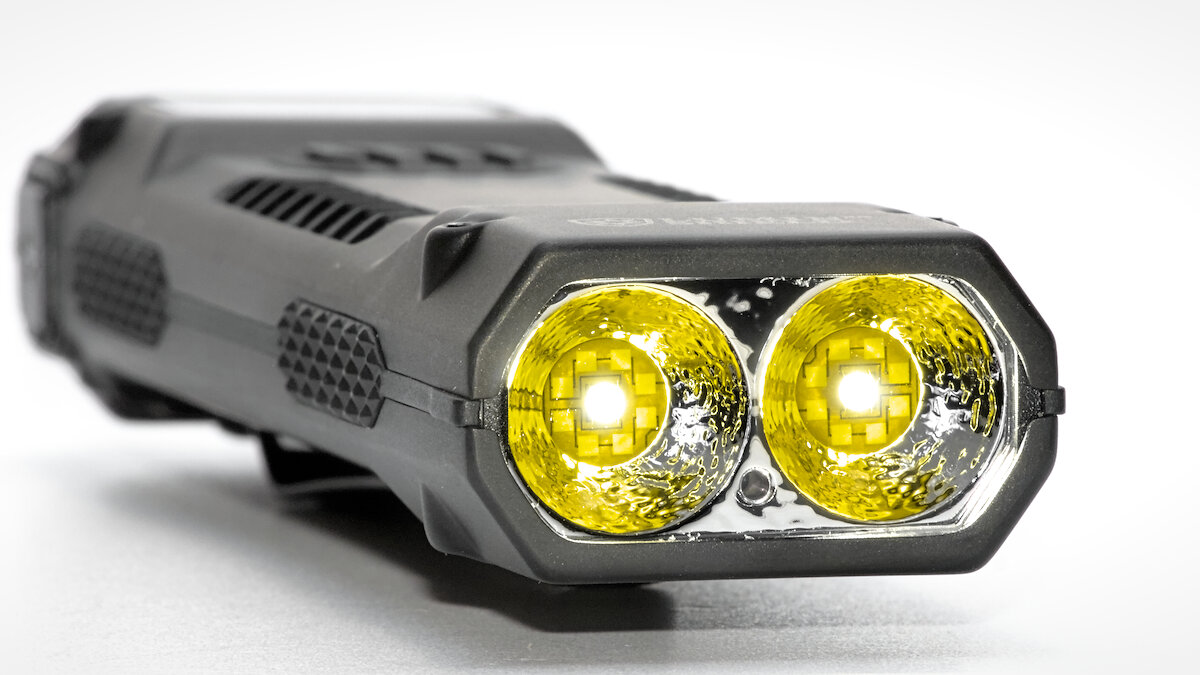
Overview of hardware
Due to the monolithic design, there are only a few accessories in the box:
- Lanyard from paracord with a small carabiner
- USB-C charging cable
- Manual (EN, DE, FR, RU, JP, KO, IT, UA, CN)
The battery is integrated, the clip already attached and there is no need for replacement seals as everything is screwed together. The instructions are comprehensive and easy to understand.
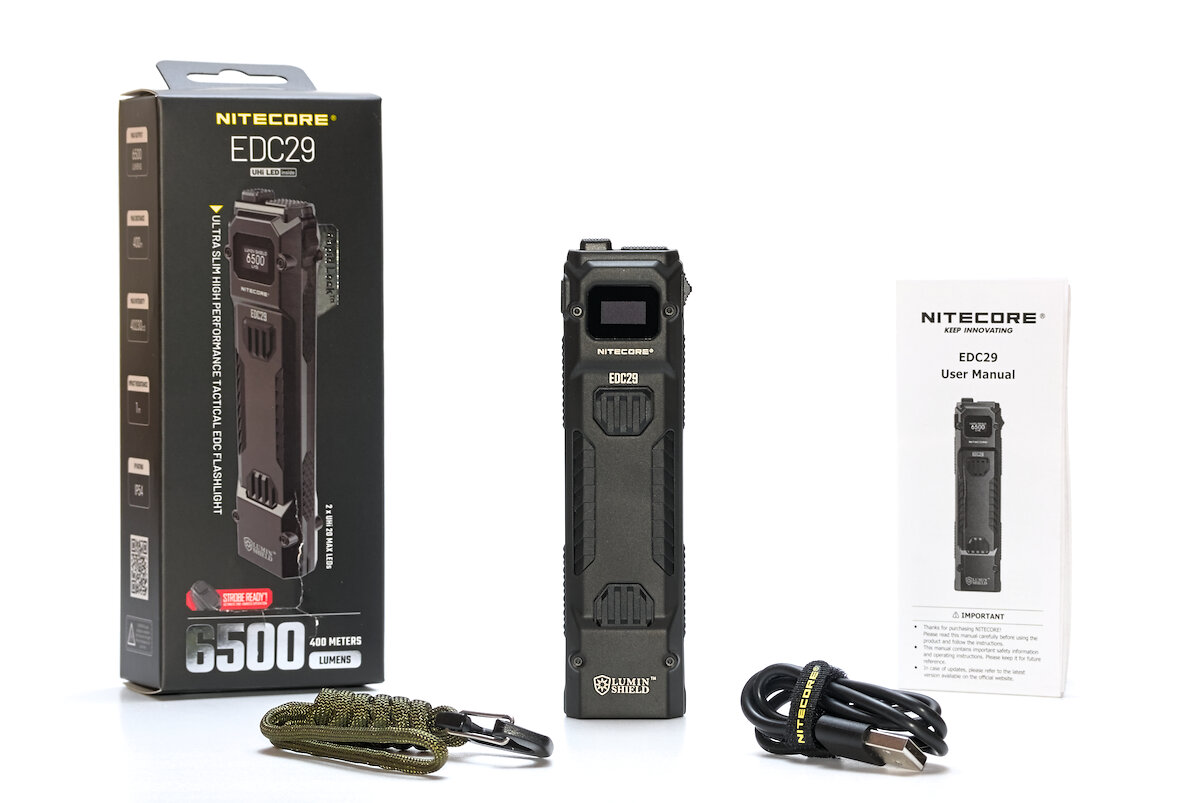
The EDC29 feels well proportioned to me. The middle section is a little thinner, which makes the flashlight look a little more elegant and possibly also fits better in the hand.
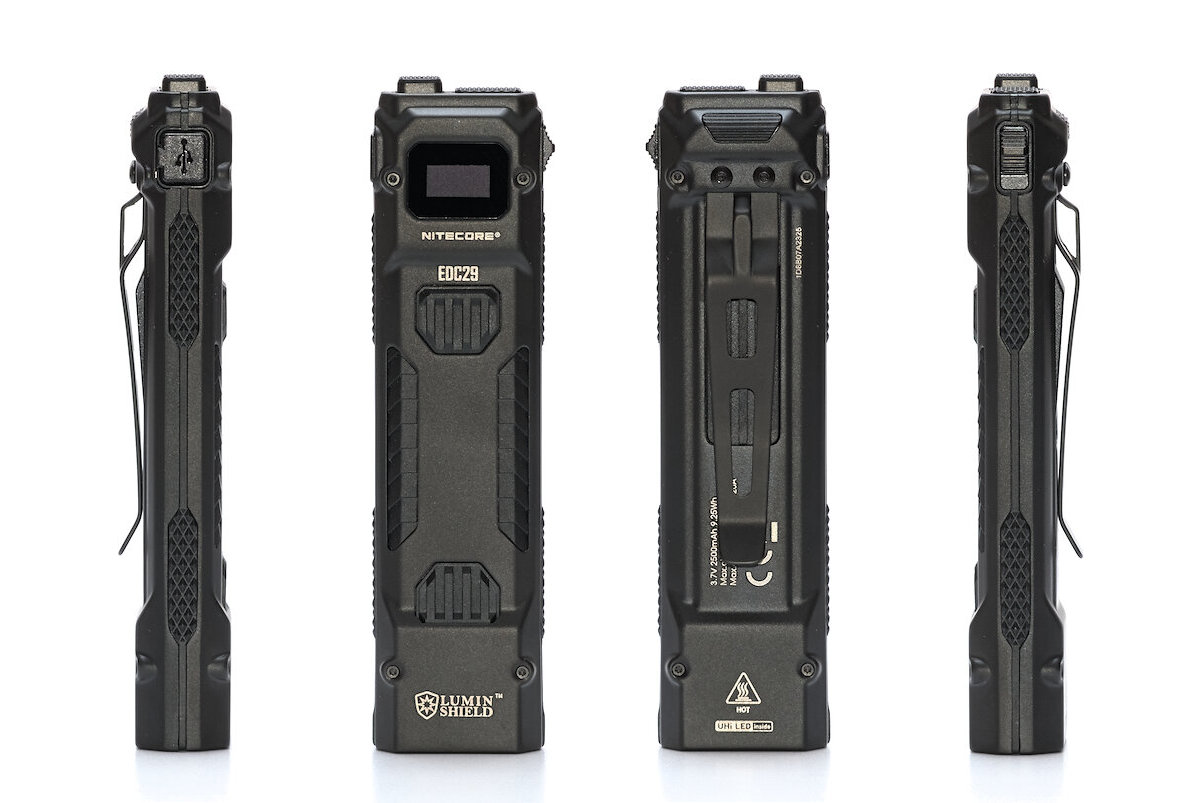
One advantage of “flat” flashlights is that they are not as bulky in the pockets of your pants as round models. From a certain length, however, it is no longer possible to sit down comfortably. The EDC29 is borderline in terms of length and it depends on the wearer whether it still fits comfortably in the pocket. However, it is comfortable to wear on the outside of your trousers or vest.
Length: 132 mm
Cross section (head): 19.1 × 34.5 mm
Cross section (middle): 15.8 × 33.4 mm
Cross section (end): 20.3 × 36.6 mm
Weight: 161 g
Compared to the small EDC23, the EDC29 looks much more grown-up and less delicate. This is not only due to the greater length, but also the thicker head.
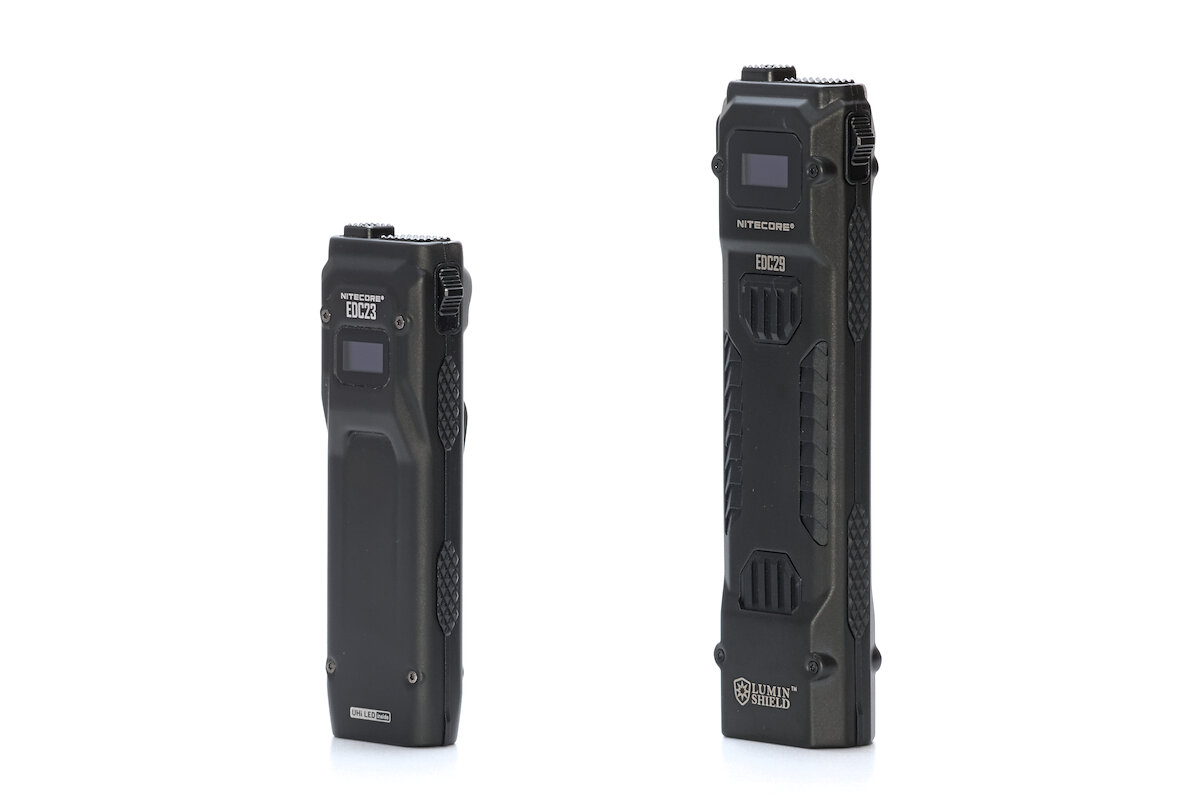
The EDC29 is also on top of the list in terms of size compared to other flashlights with a flat design. This should not be seen as negative criticism, as the EDC29 is less of an inconspicuous flashlight for evening wear and more of a serious flashlight for tactical use.
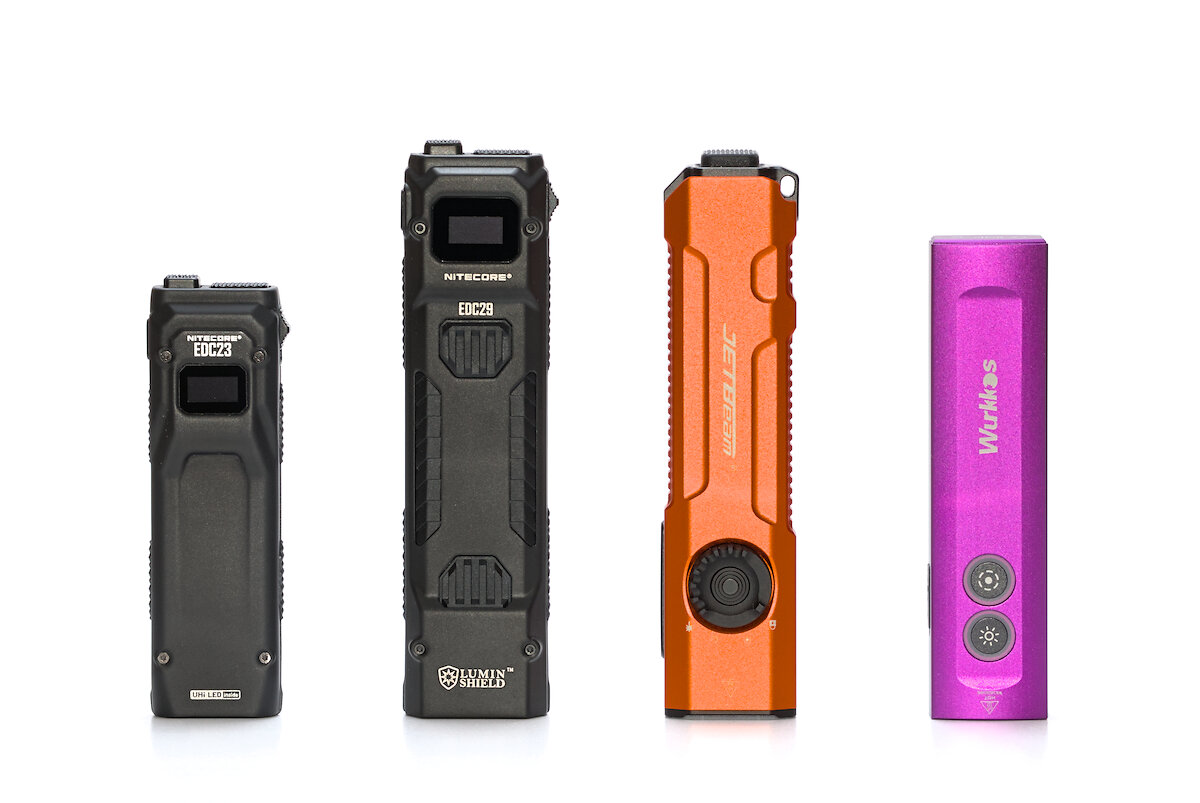
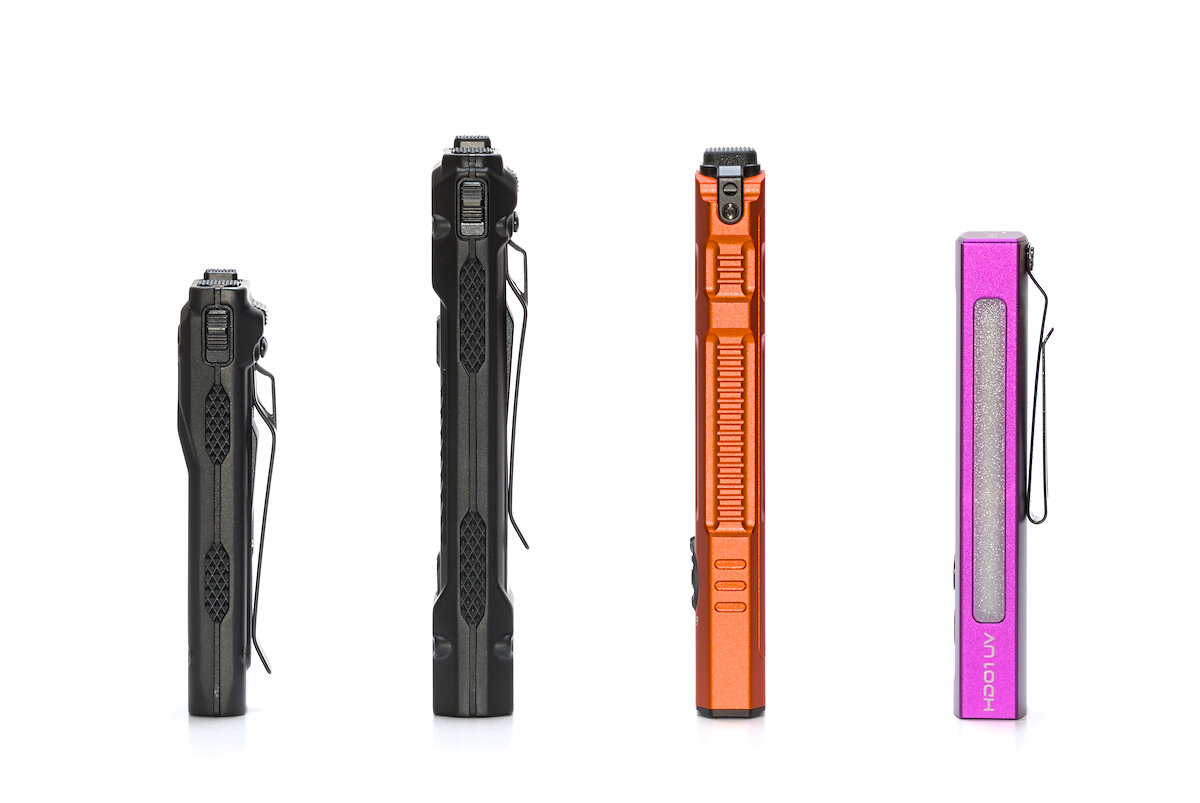
The front has several plastic design elements. They have a slightly anti-slip effect, but otherwise serve no real functional purpose.
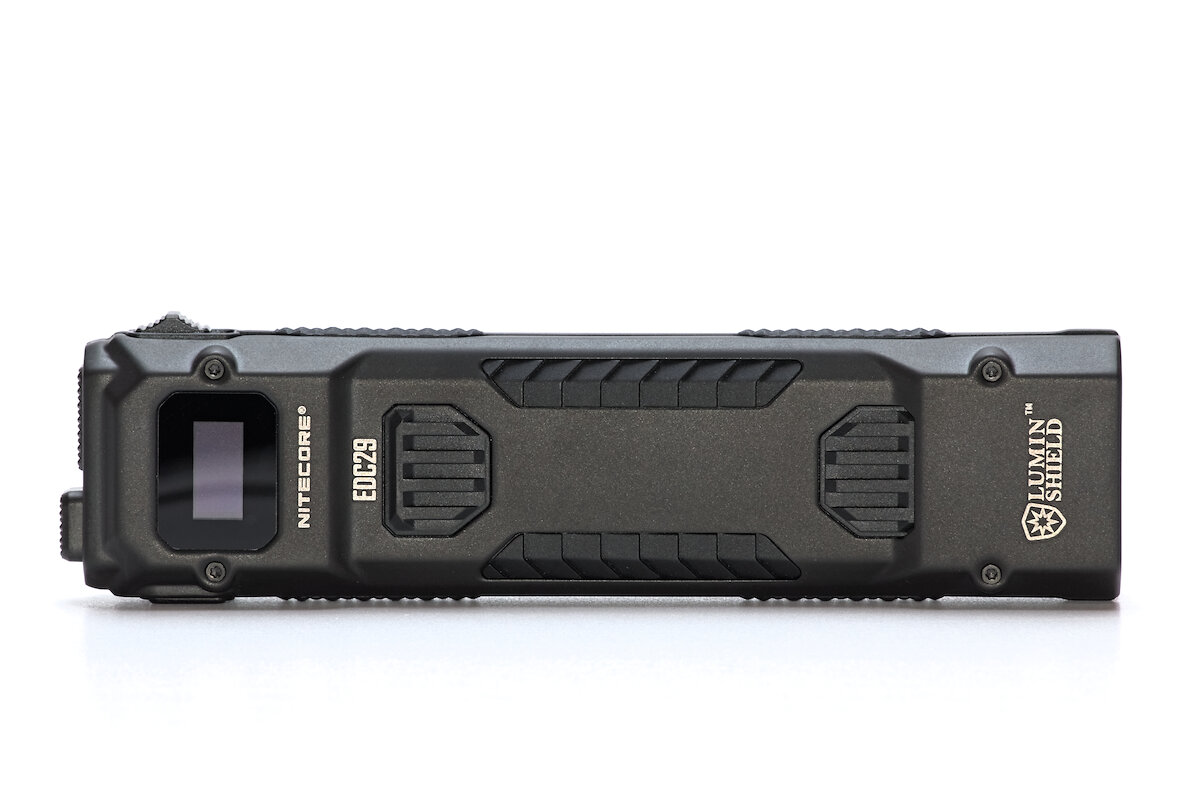
The flattened, octagonal head contains the two adjacent emitters.
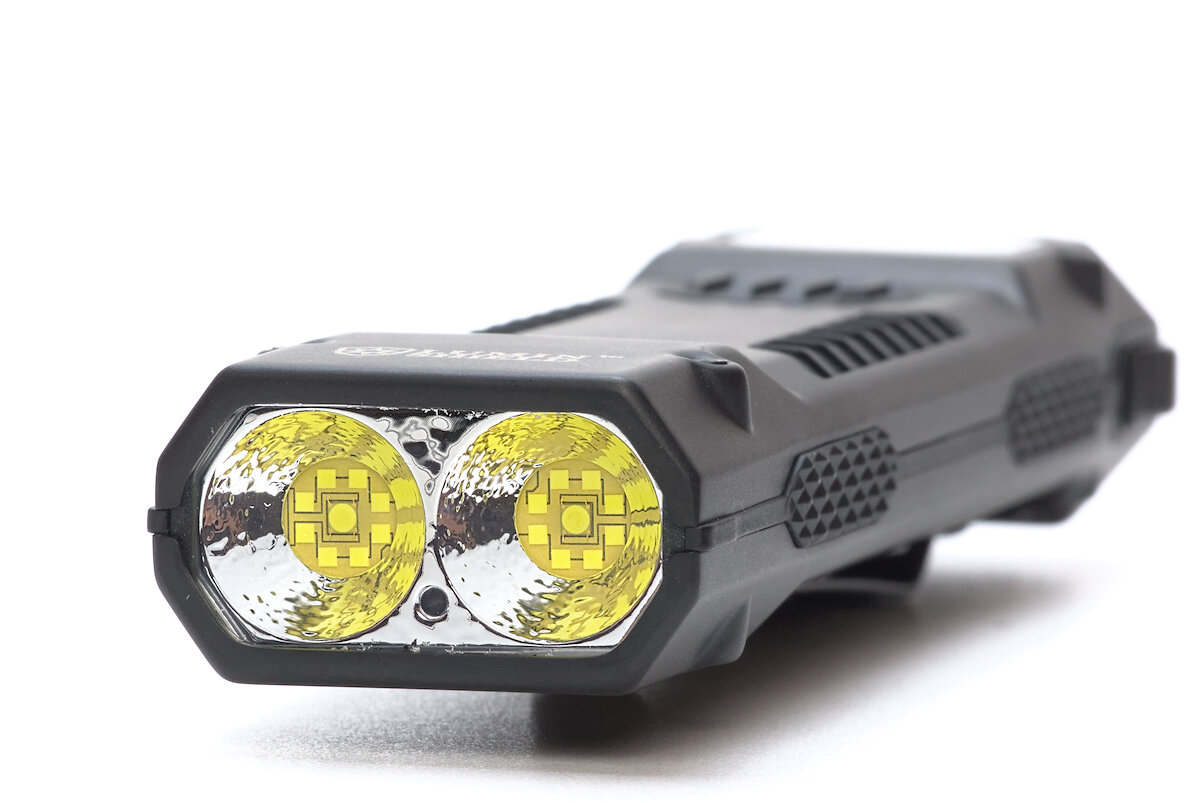
There are two plastic grip zones with a ribbed surface on each side. They are located exactly at the points of contact with the hand and improve grip.
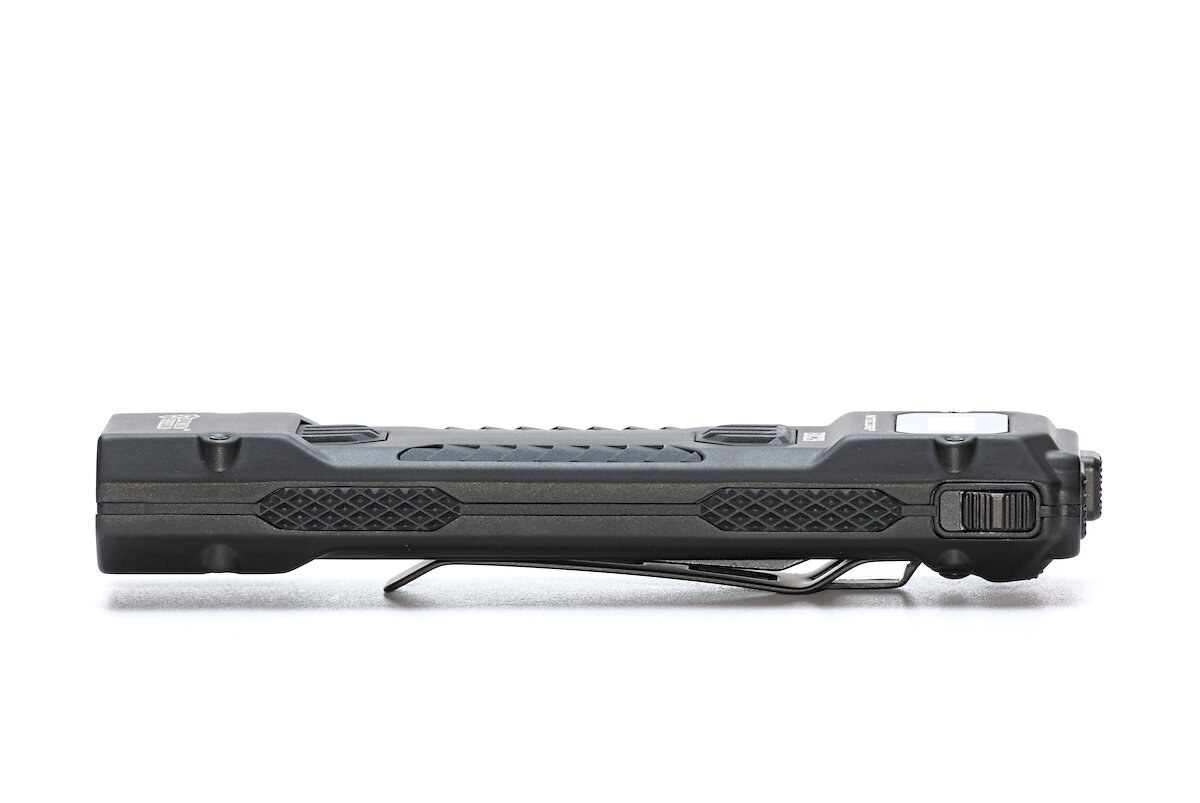
The buttons are also made of plastic and have a diamond-shaped knurling.
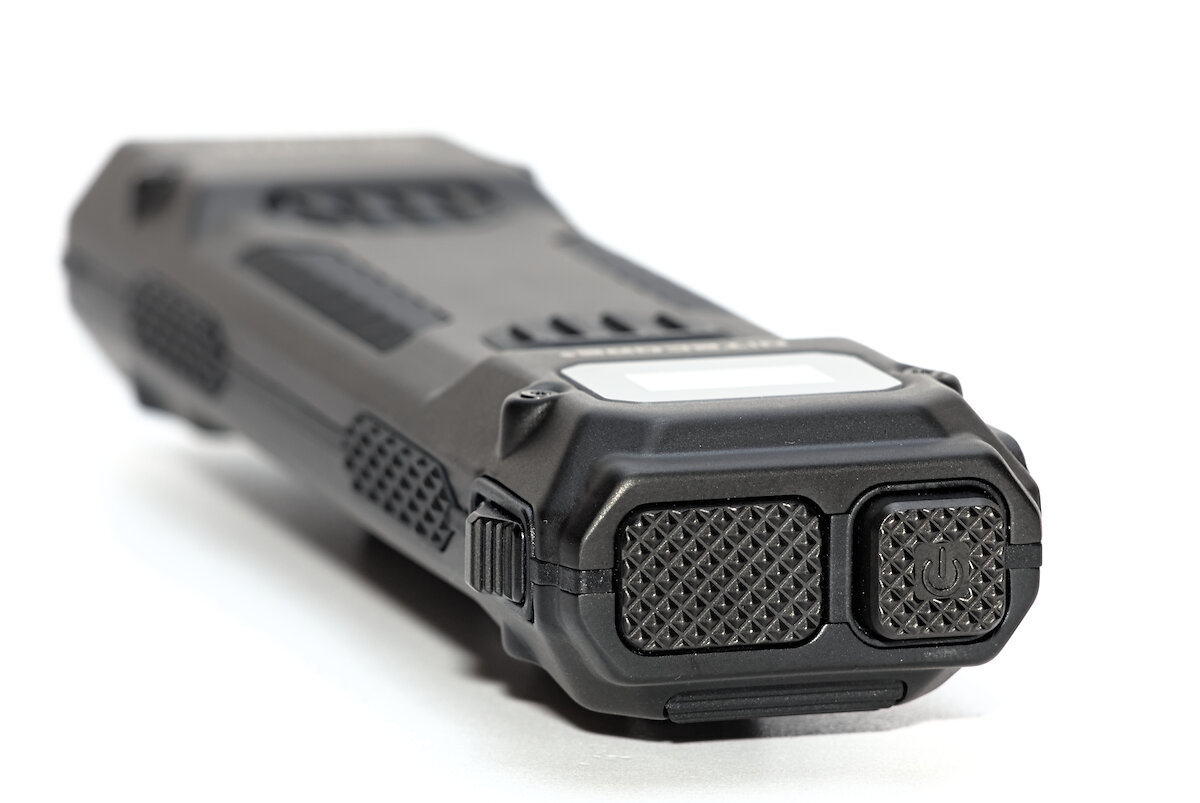
The back of the EDC29 is dominated by a large clip. It is attached with two T6 screws and can be easily removed with a suitable screwdriver.
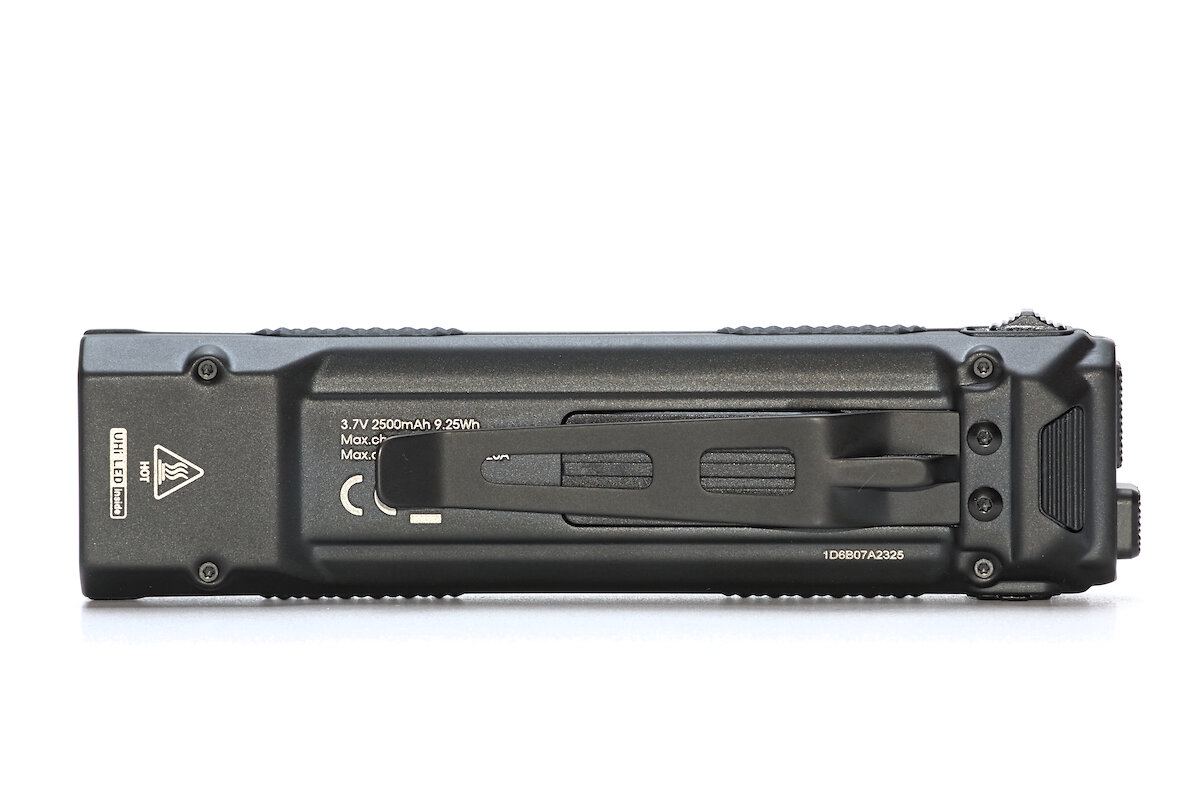
The opening of the clip sticks out a long way, making it easier to insert, but it can also be a little annoying. There is a hole at the rear end for attaching the lanyard. However, if the clip is removed, the lanyard can no longer be attached. (Exception: You could thread a thin cord through the holes of the screws.)
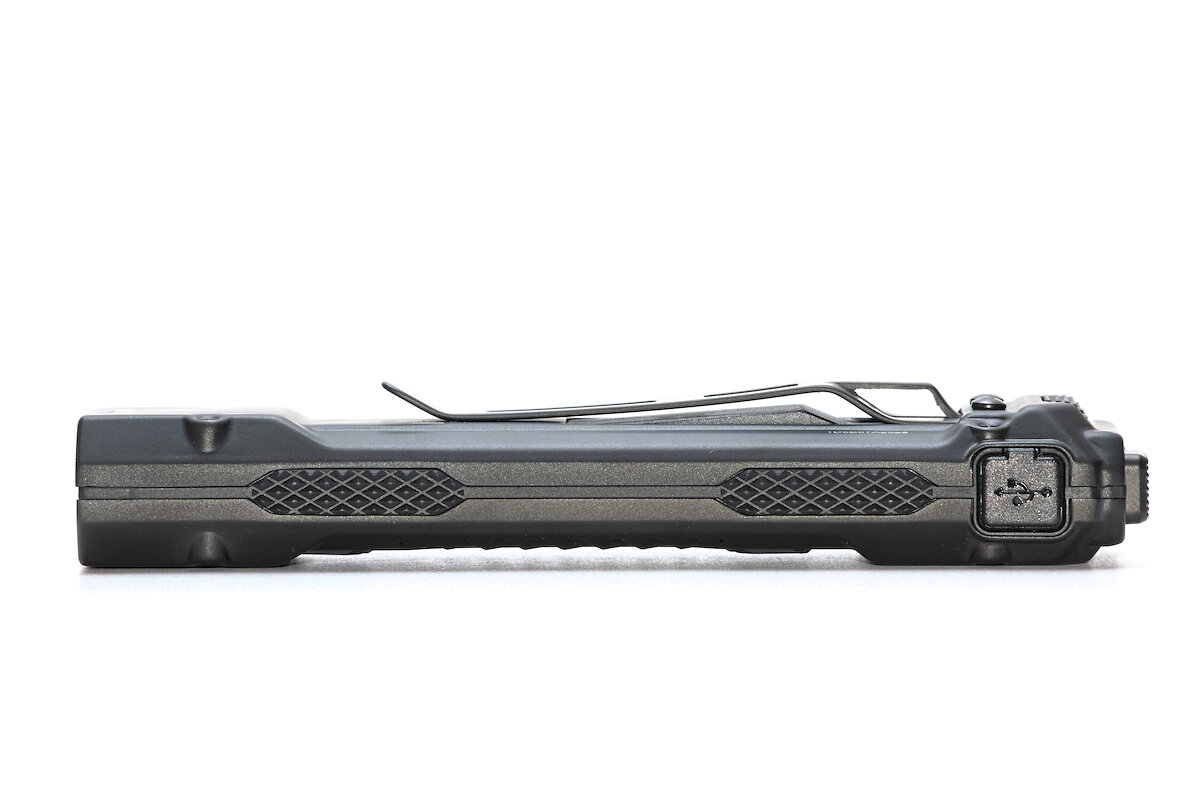
Due to the shape of the clip, the EDC29 protrudes around 35 mm from the pocket. As the flashlight is less suitable for deep carry anyway due to its overall length, I do not consider this point to be a serious problem, but the clip could have been solved better in my opinion.
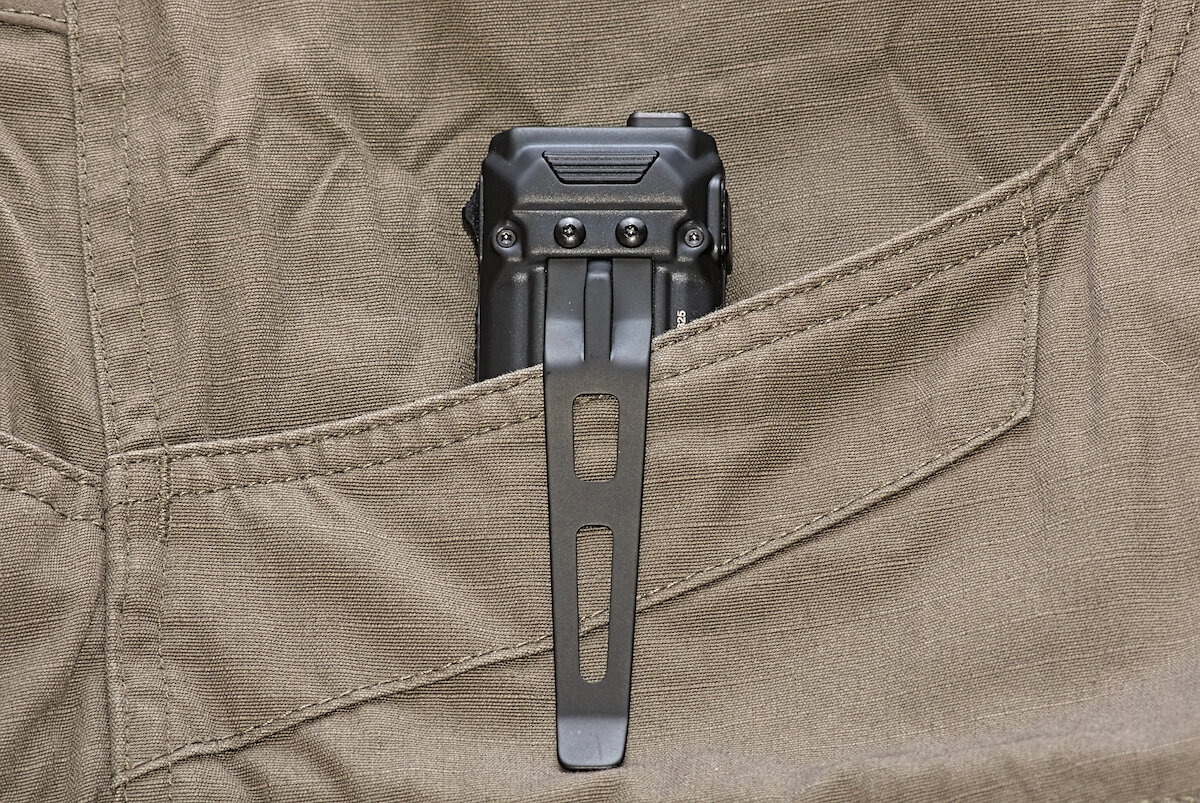
The EDC29 has multiple layers: The electronics are located in a plastic frame, which is surrounded by molded metal shells. To improve the cooling of the LEDs, the heat is transferred with something like a heat pipe to the backside of the flashlight, where it is dissipated via a large heat sink. It is covered by the clip so that it is not normally touched directly.
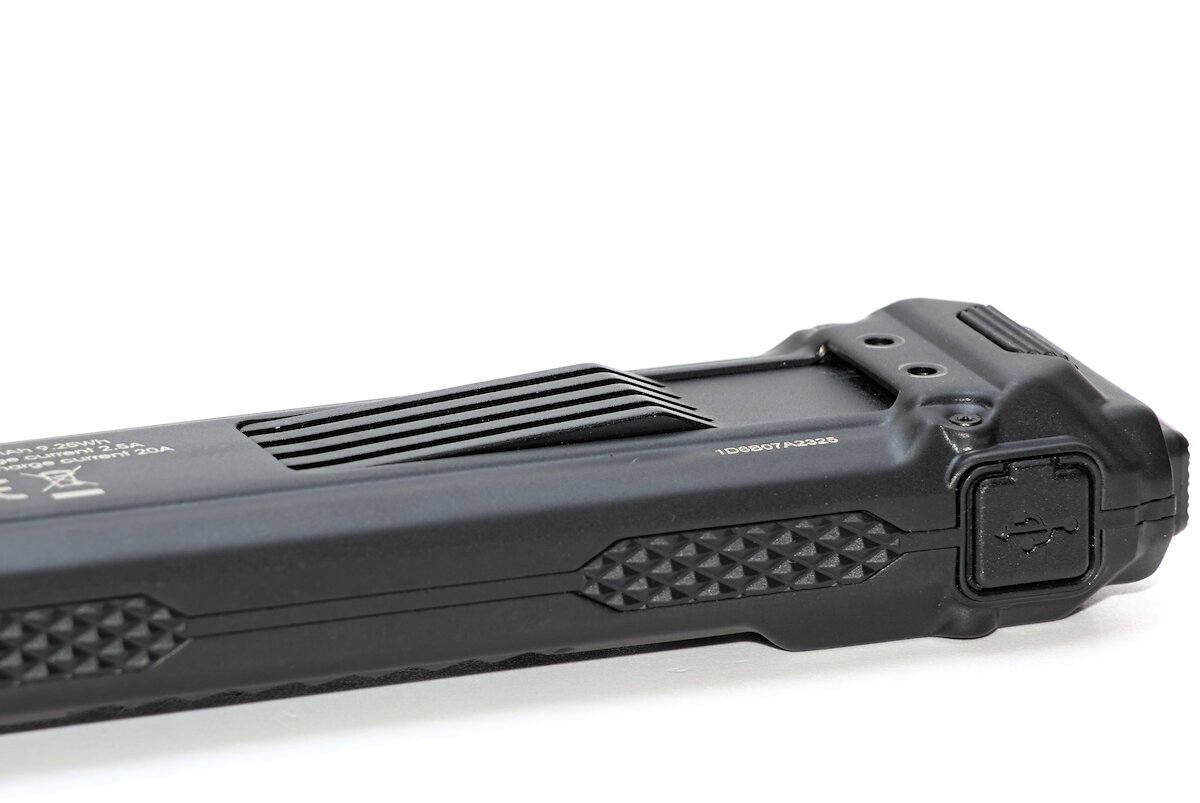
The flashlight is charged via USB-C. A cover provides a certain degree of protection against dirt and water. Its outer side is made of solid plastic, while the inner half is made of silicone. This provides a good seal, but is very easy to open and close.
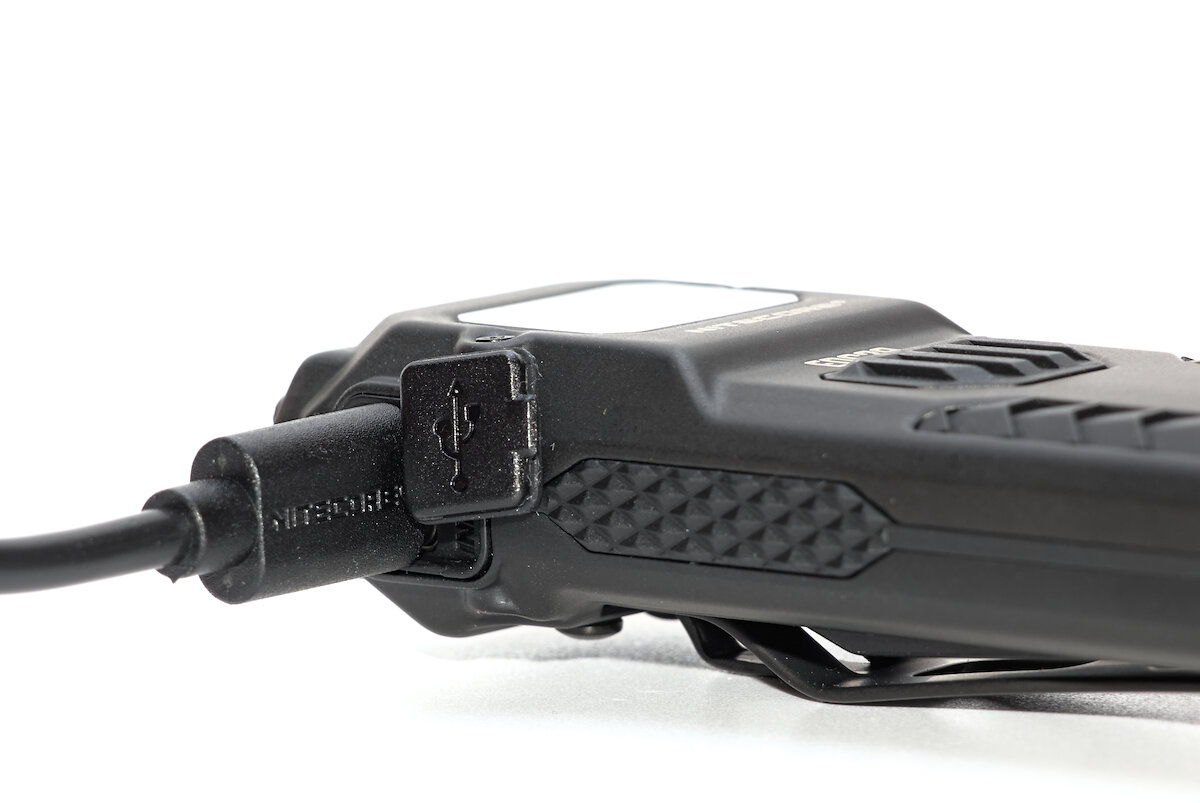
The charging progress can be seen on the OLED display. Instead of a percentage display, the battery voltage is shown. The display is active both during charging and afterwards until the USB cable is disconnected.
At almost 2.5 A the charging process is pleasantly fast and is completed after just over one hour. During charging, the flashlight can be used normally - with the exception of Search and Lumin Shield / Strobe.

The build quality makes a very good impression. However, I am concerned about the specified protection of only IP54. The last number indicates the protection against water and in this case means “protection against splashing water”. A few raindrops are certainly no problem for the EDC23, but if the flashlight lands in a puddle, it could be damaged. An EDC flashlight - and especially a tactical one - should be able to withstand a little more. Tim McMahon recently disassembled the very similar EDC29 and documented the process in a video:
There are apparently no proper seals. This means that water can penetrate, particularly in the area of the buttons, but it also finds a way under the metal shells. Covering the USB port is therefore unlikely to have much effect.
At some point, the performance of the battery will start to drop. As it is permanently integrated and cannot be replaced, this also means the end for the flashlight. A compromise that has to be made with most flashlights of this design. Easier repairability would have made sense.
User interface
From a “tactical” flashlight I expect a well thought-out user interface that allows for reliable operation even in stressful situations. Quick access to turbo and maybe strobe as well as a predictable brightness when turning it on (either always start at the same brightness or reliable memory) are useful.
The EDC23 achieves this by using multiple buttons: a slightly protruding power button, a flat mode button and a sliding lock switch. Both buttons have two electronic stages of actuation.
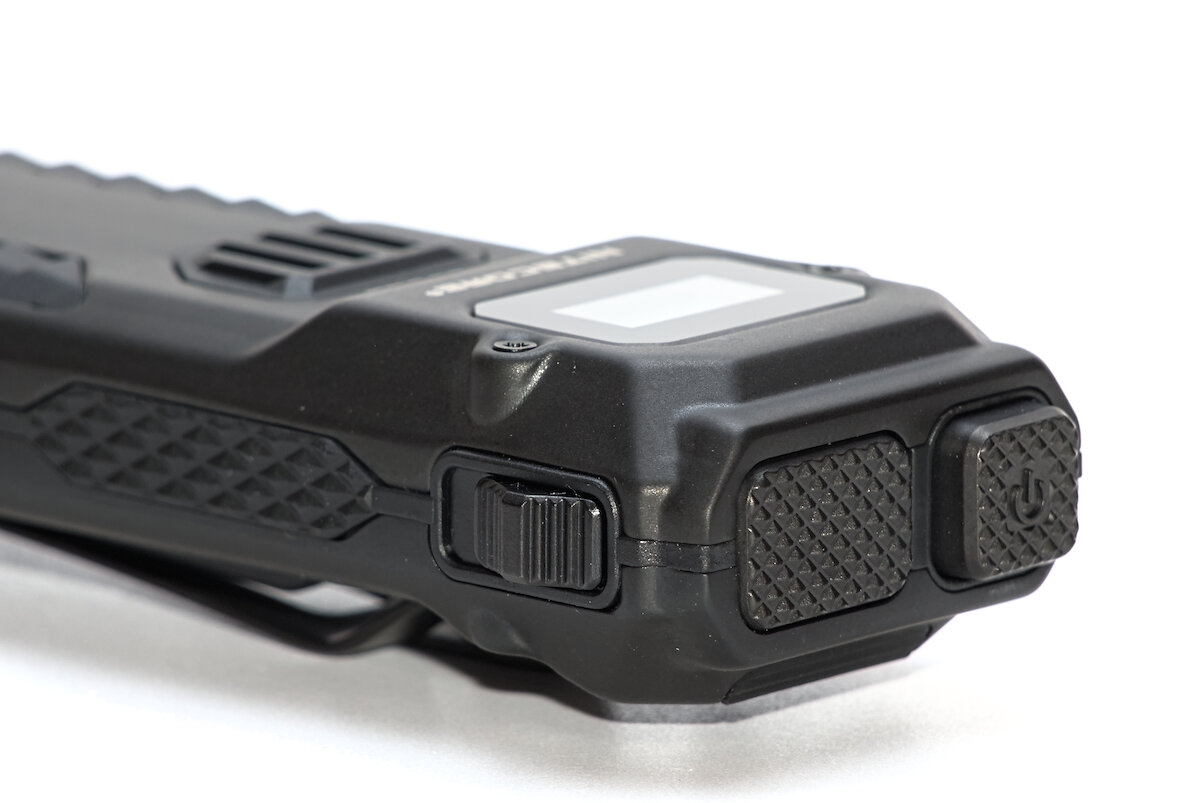
The flashlight is switched on and off by fully pressing the Power button to the second stage (1200g actuation force). By briefly tapping it to the first stage (450g), the brightness can be gradually increased in four steps when the flashlight is switched on: Ultralow, Low, Medium and High.
If the button is tapped when the flashlight is switched off, the brightness can be pre-selected in advance (the level is shown on the display). Holding the power button in the first stage temporarily activates Ultralow mode, both when the flashlight is switched off and when it is on (for example, to check a document and briefly reduce the brightness to avoid being blinded).
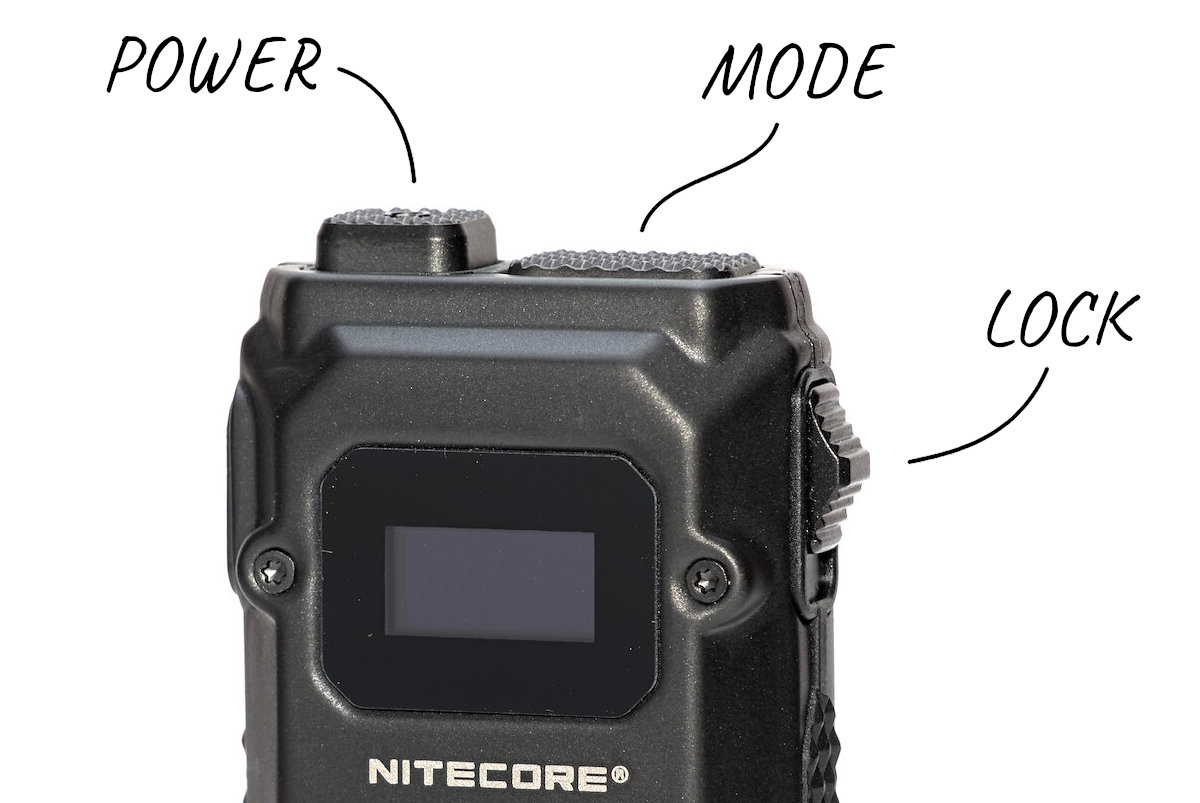
The Mode button gives you direct momentary access to “Search” and “Lumin Shield” or strobe. During use, a progress bar on the display shows the remaining runtime - and it moves fast! When the flashlight is cold, a maximum of eight seconds at a time is possible and then the flashlight switches down to a lower level. If you release the button, the progress bar slowly fills up depending on the temperature. This means that the turbo modes can only be used for a short time when the flashlight is already warm. As I only ever use Turbo for short periods, the short runtime has never bothered me. It really is just a turbo and not a permanent level (you need a larger flashlight for this).
“Search” is activated by holding the mode button in the first stage (450g). If you press the mode button all the way down to the second stage (950g), you activate either “Lumin Shield” or strobe. More details on these modes in the next section.
To switch between “Lumin Shield” and strobe, press and hold the mode button, then press the power button. Strobe does not only change the frequency regularly, but also the duty cycle is adjusted. This makes the strobe particularly disorientating.
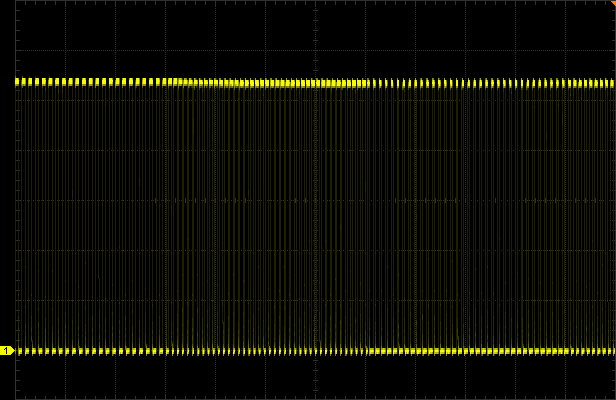
That leaves the lockout, called “Rapid Lock”: A slide switch at the side locks all buttons when in the upper position. This is referred to as “Full Lockout (Lockout 2)”.
If you hold down the Mode button while activating the lockout, you enter the “Semi Lockout (Lockout 1)”, in which only the Power button is locked. The mode button is then still available for Search and Lumin Shield / strobe.
It works really well in practice: just pull it down with your thumb and the flashlight is ready. There is no need to press the button several times and the current status can also be seen and felt immediately. It can also be used to turn off the flashlight, so there is no need for extra button presses.
The switch works with a magnetic sensor. That means that the function can be disrupted by a strong magnet, so that the flashlight can either be switched off or the lockout temporarily deactivated. I don’t see this as a disadvantage for normal use.
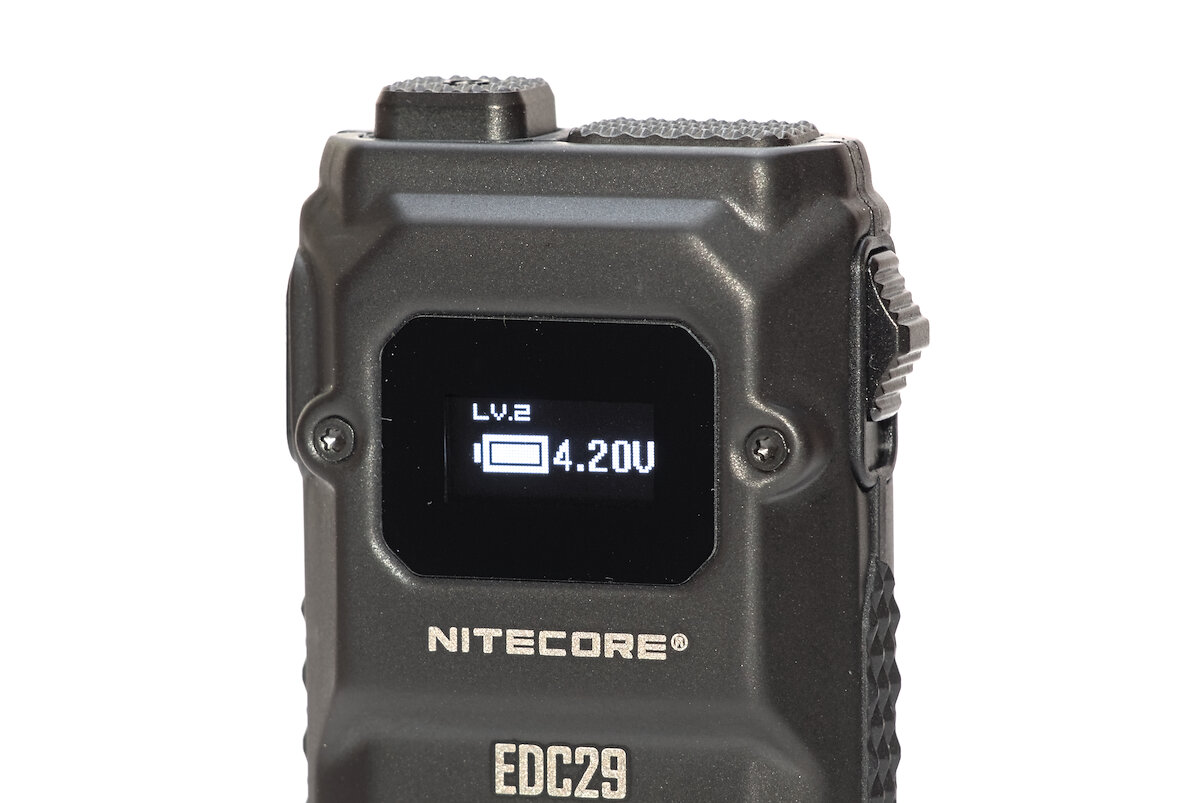
When the flashlight is switched on and each time the button is pressed, the current status is shown on the OLED display for 10 seconds. The current level and the remaining runtime at this level appear one after the other. When the flashlight is switched off and the power button is pressed, the selected level and the battery voltage are displayed for two seconds.
This display is somewhat gimmicky. A few LEDs like on the EDC25 would probably have been sufficient. On the other hand, it doesn’t really bother me and the display of the remaining runtime is extremely practical.
A special feature is hidden between the two LEDs at the front: a brightness sensor that reduces the brightness when an object is detected in front of the emitters. This is intended to reduce the risk of fire if the light is switched on unintentionally. However, the sensor is only active in the High level and only directly when the light is switched on. After triggering, it can be temporarily deactivated by briefly tapping the power button. In practice, I have never noticed any negative effects of this function.

I was impressed with the handling of the EDC29. It sits comfortably in the hand and can be operated completely with the thumb without having to reach around. It feels much larger and heavier than the small EDC23 and is comfortable to hold even when wearing gloves.
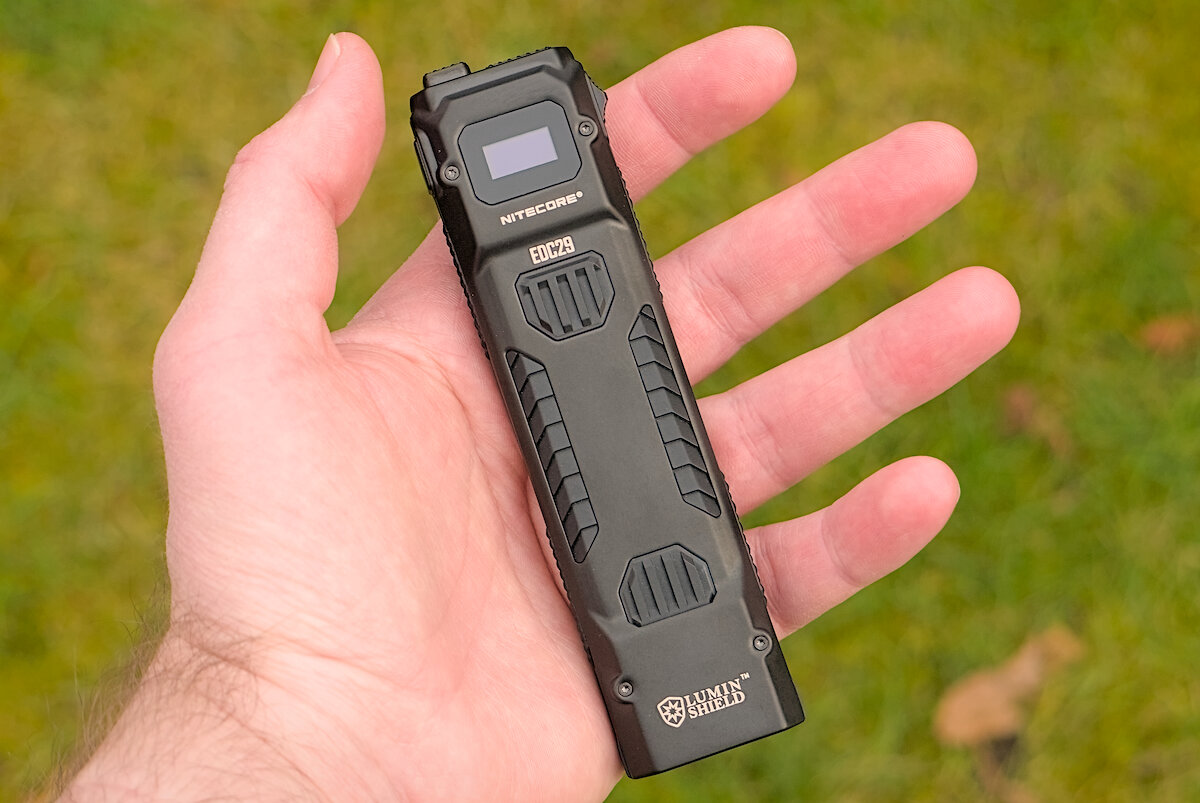
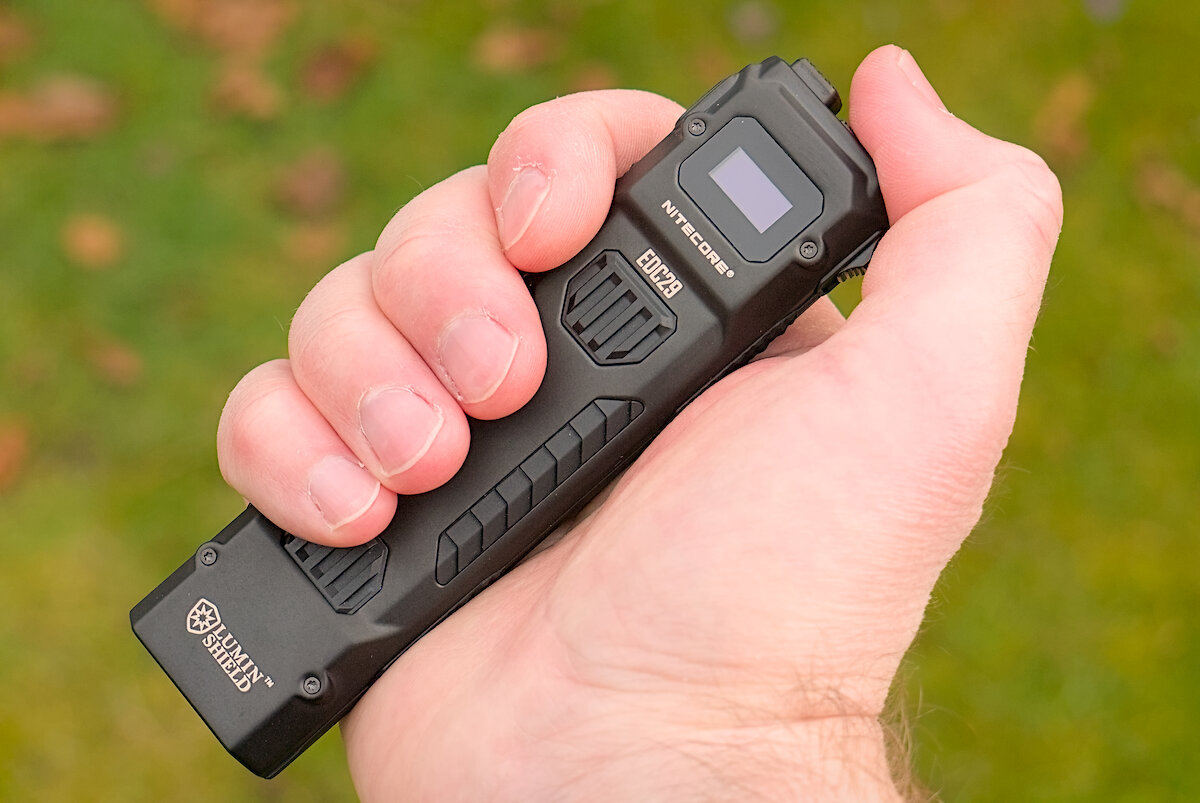
Illumination
These LEDs are not available from other manufacturers, as they were developed by Nitecore under the name “UHi 20 MAX”. The special feature: they consist of nine individual light emitting surfaces, some of which can be controlled independently of each other.
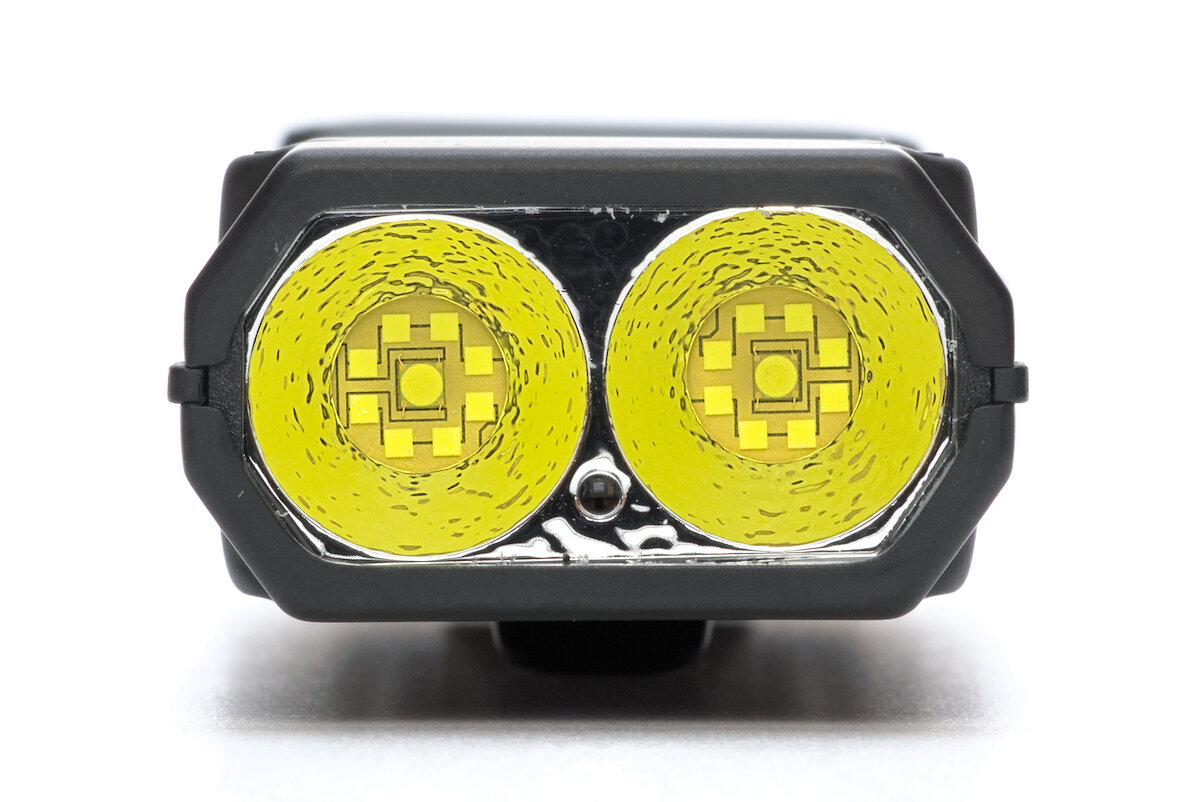
In the center is a die with a small, round light emitting surface. This makes it easy to focus and ideal for a thrower. It is surrounded by eight other dies, which increases the effective LES of the LED, making it significantly more floody. A textured reflector (“orange peel”) smoothes the beam so that the outer dies merge completely with each other. The glass in front of the emitters has a magenta-colored anti-reflective coating.
In the Ultralow, Low and Search levels, only the middle die is used, resulting in a relatively narrow beam. In Mid, High and Lumin Shield, the outer dies are also switched on, resulting in an extremely bright spill. This also explains the name “Lumin Shield”: A wall of bright light, which is designed to dazzle and distract an attacker.

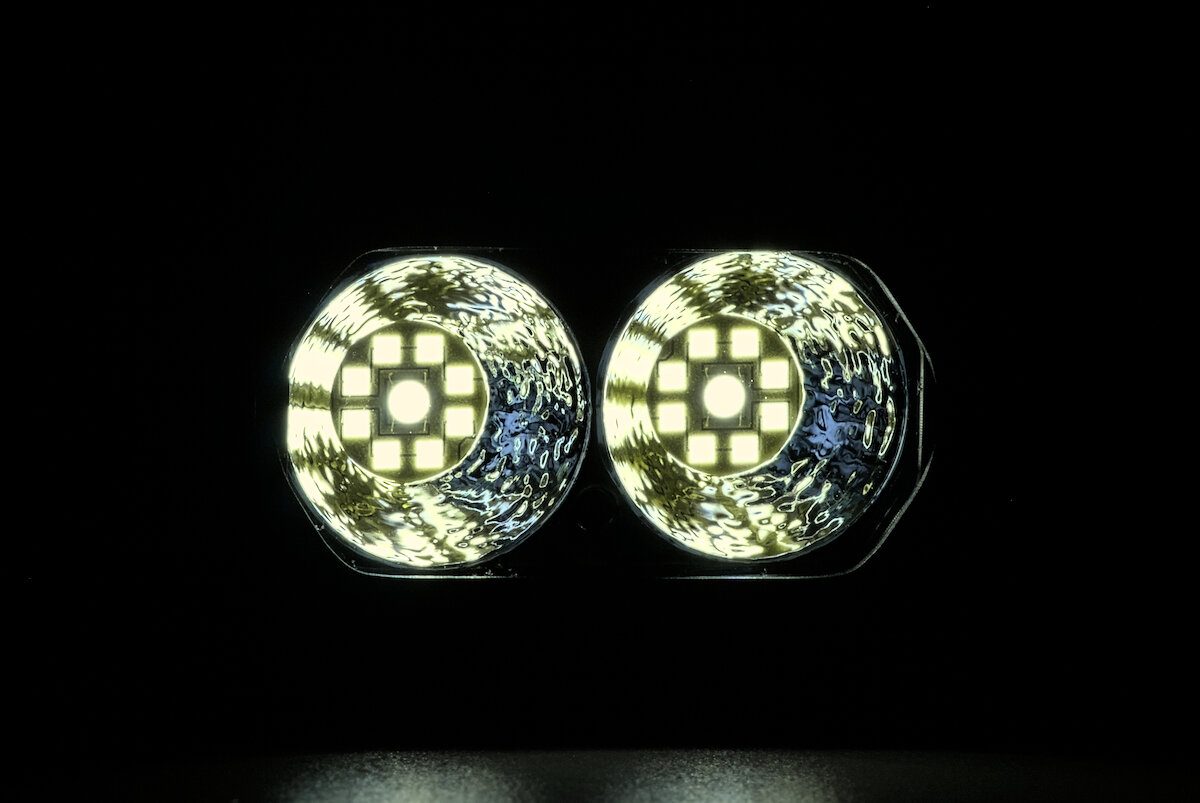
Unfortunately the choice of dies used is linked to the brightness levels. It would have been nice to be able to choose between a wide and a narrow beam at all levels. Especially at low levels and at short distances, the beam is too narrow for my taste.
Depending on the level, the color temperature is around 6000 K. In the lower levels, a slightly greenish tint can be seen, which disappears in Search and Lumin Shield.
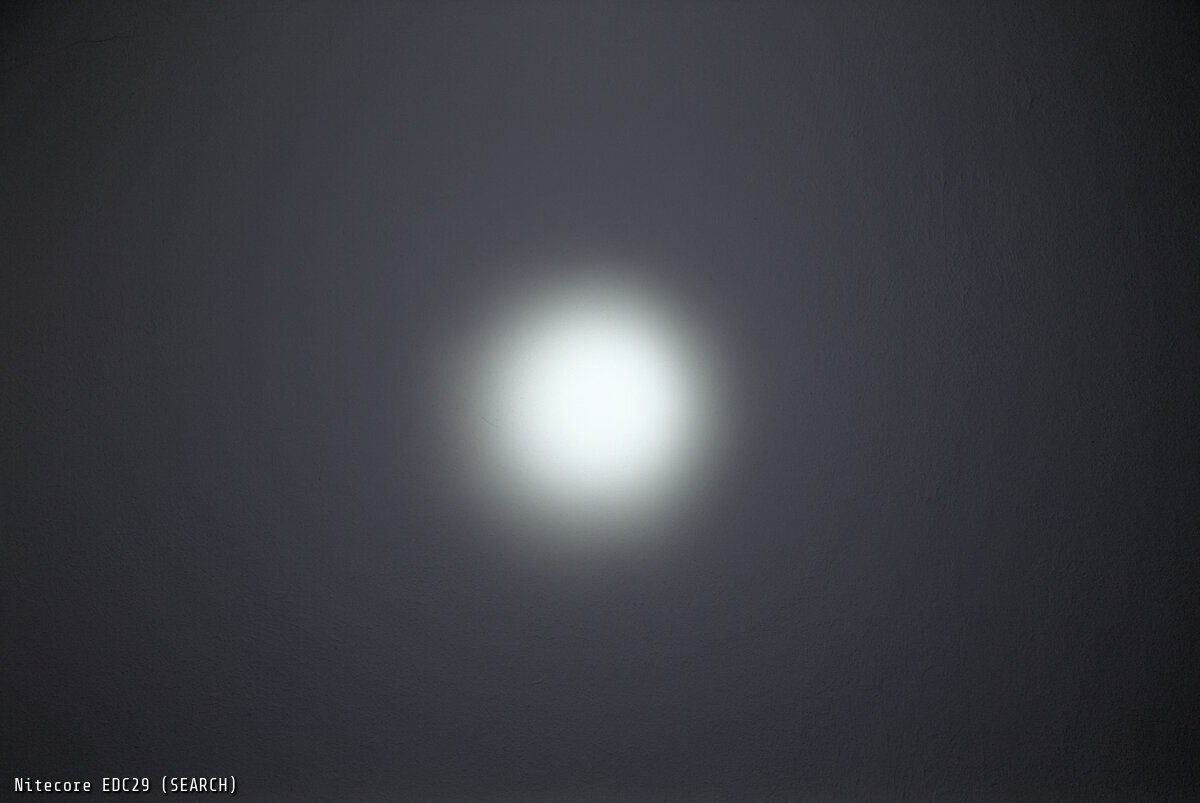
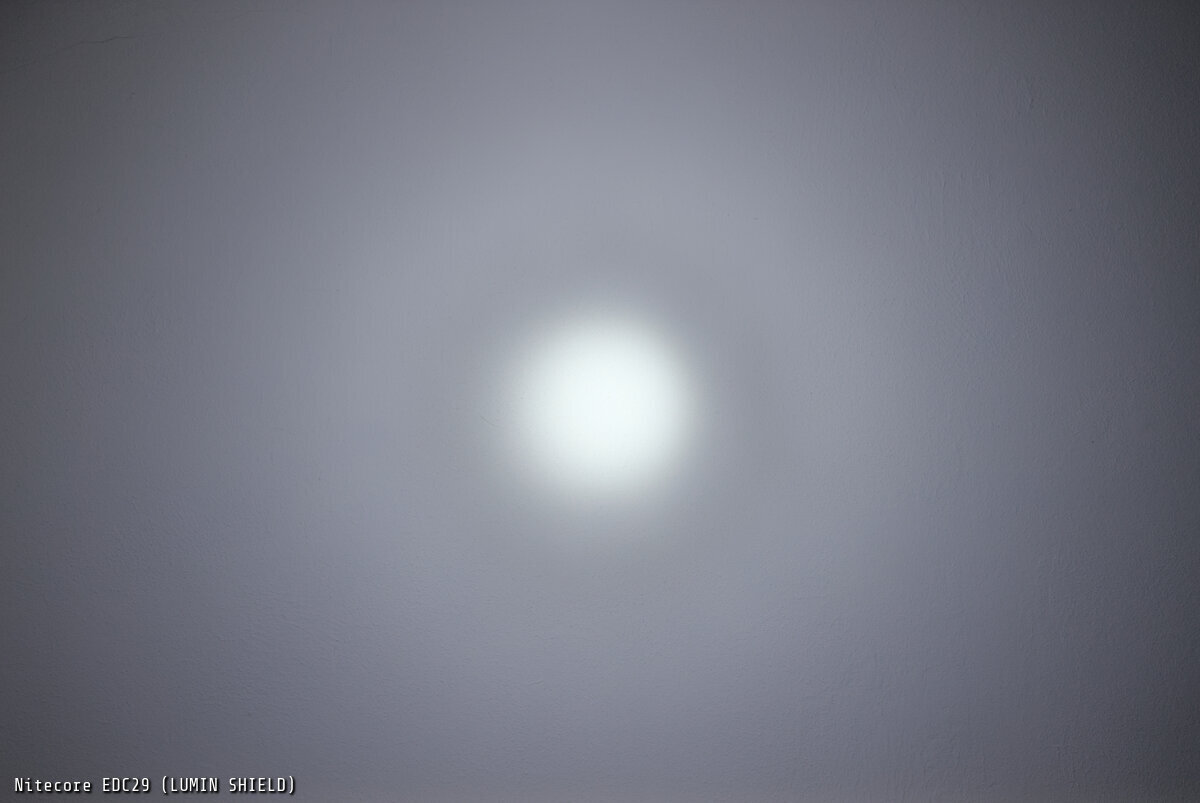
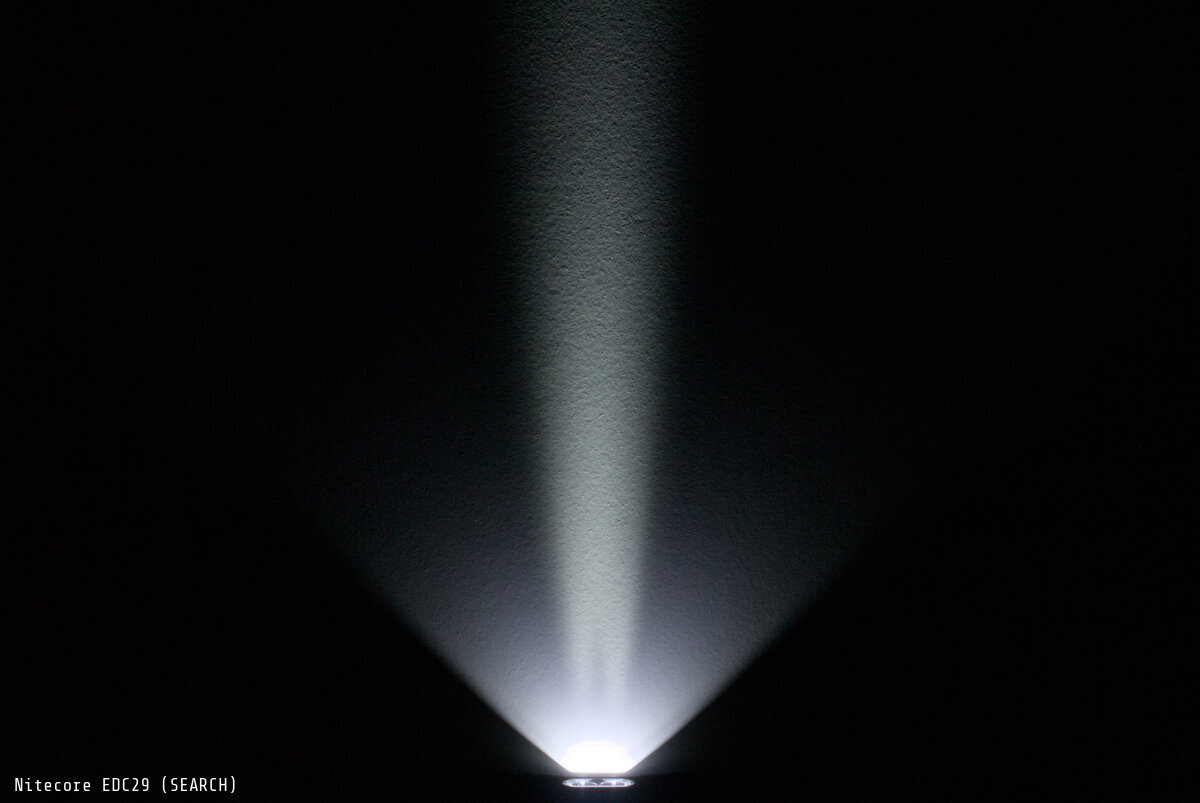
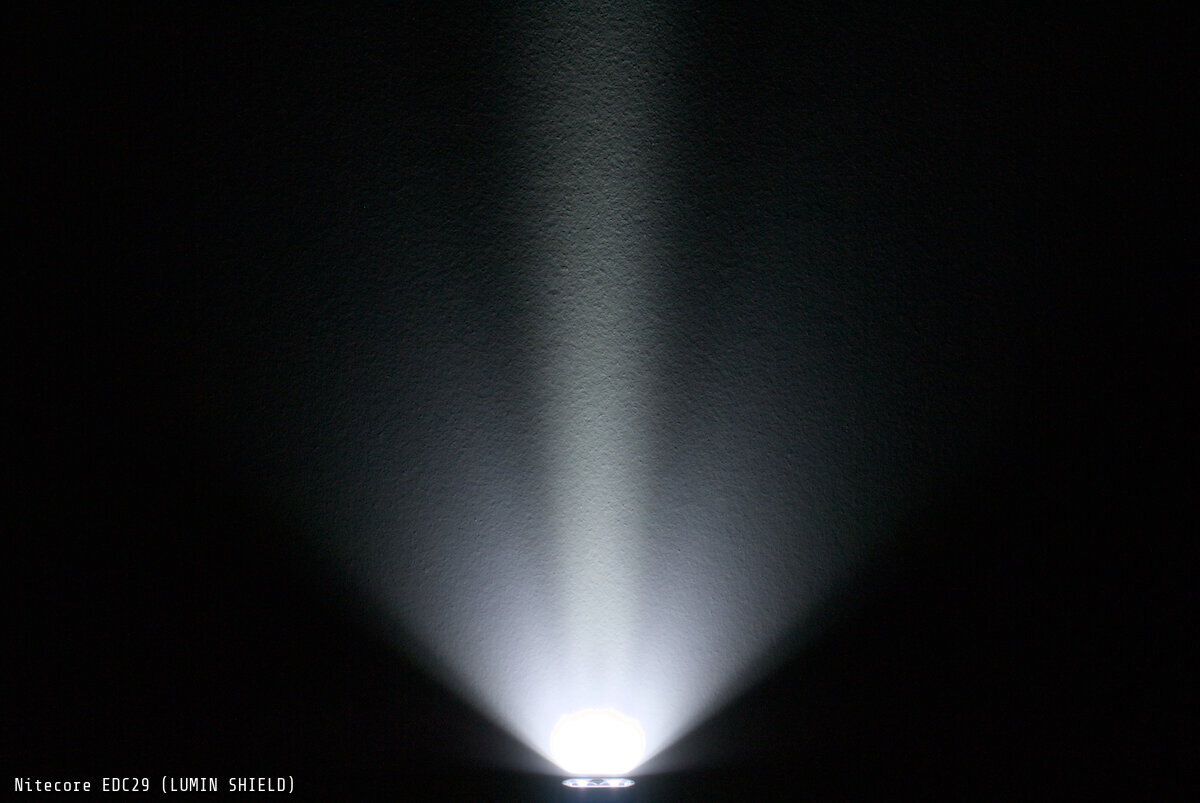
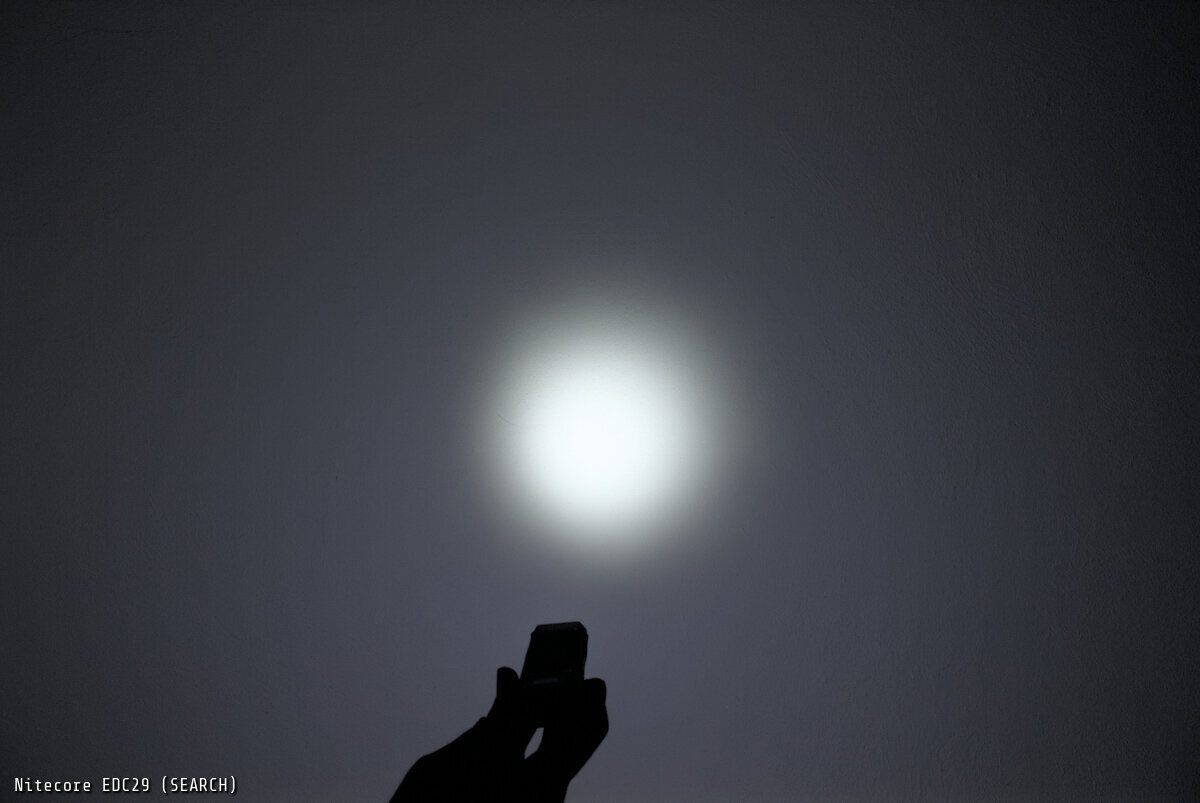

For the outdoor beamshots I used the Nitecore EDC23 for comparison. In “Search” mode, the EDC29 has a narrower beam and slightly more throw. In “Lumin Shield” mode the EDC29 has a higher total brightness.
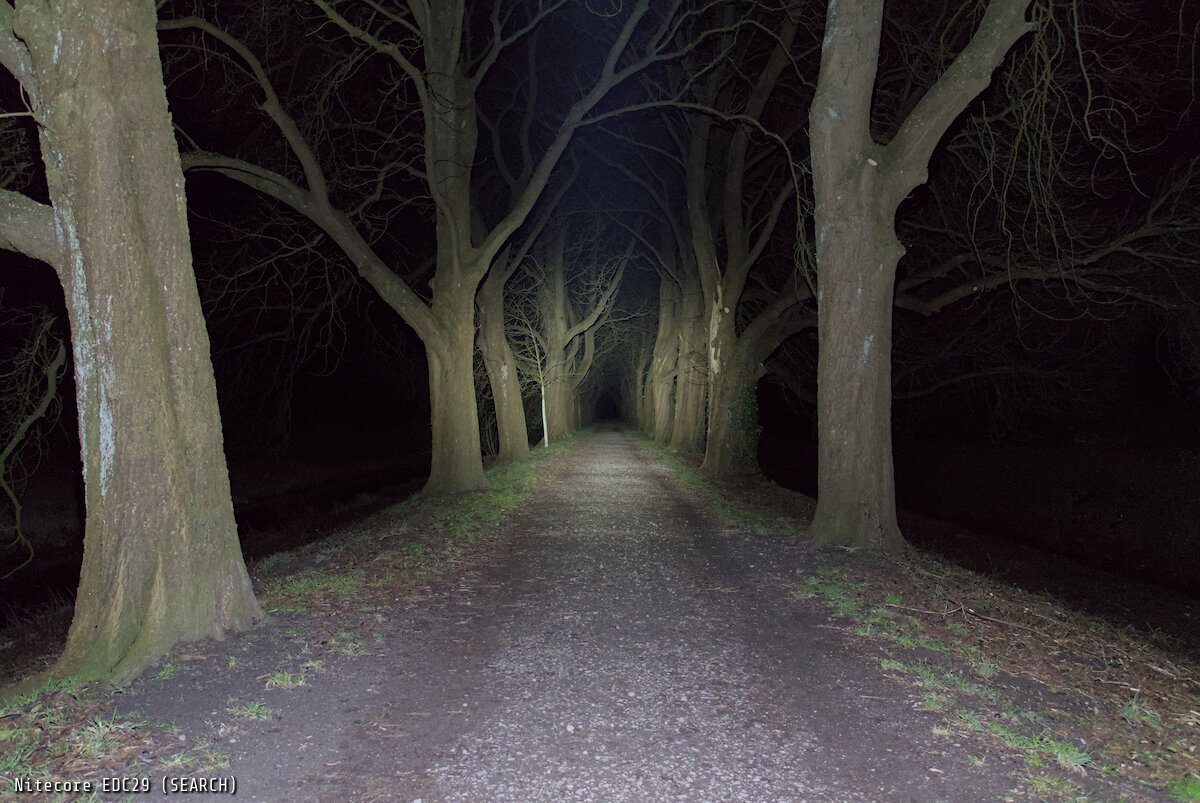
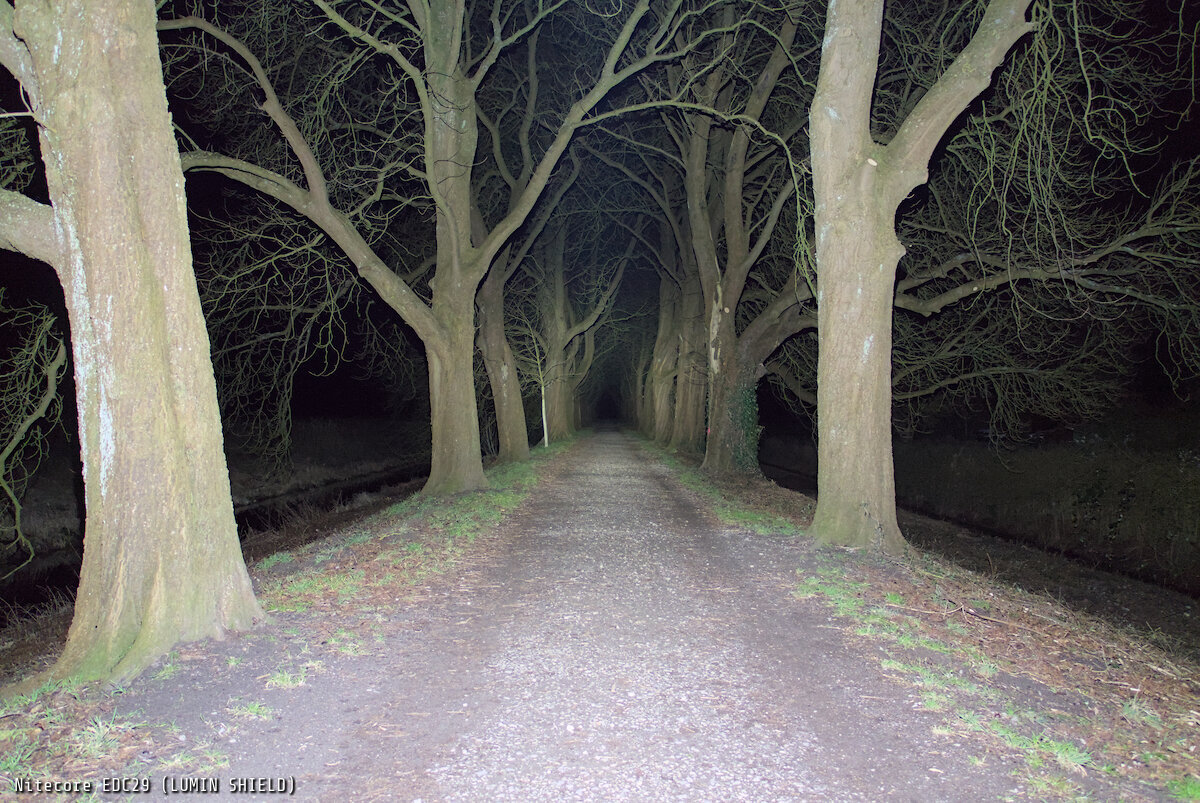
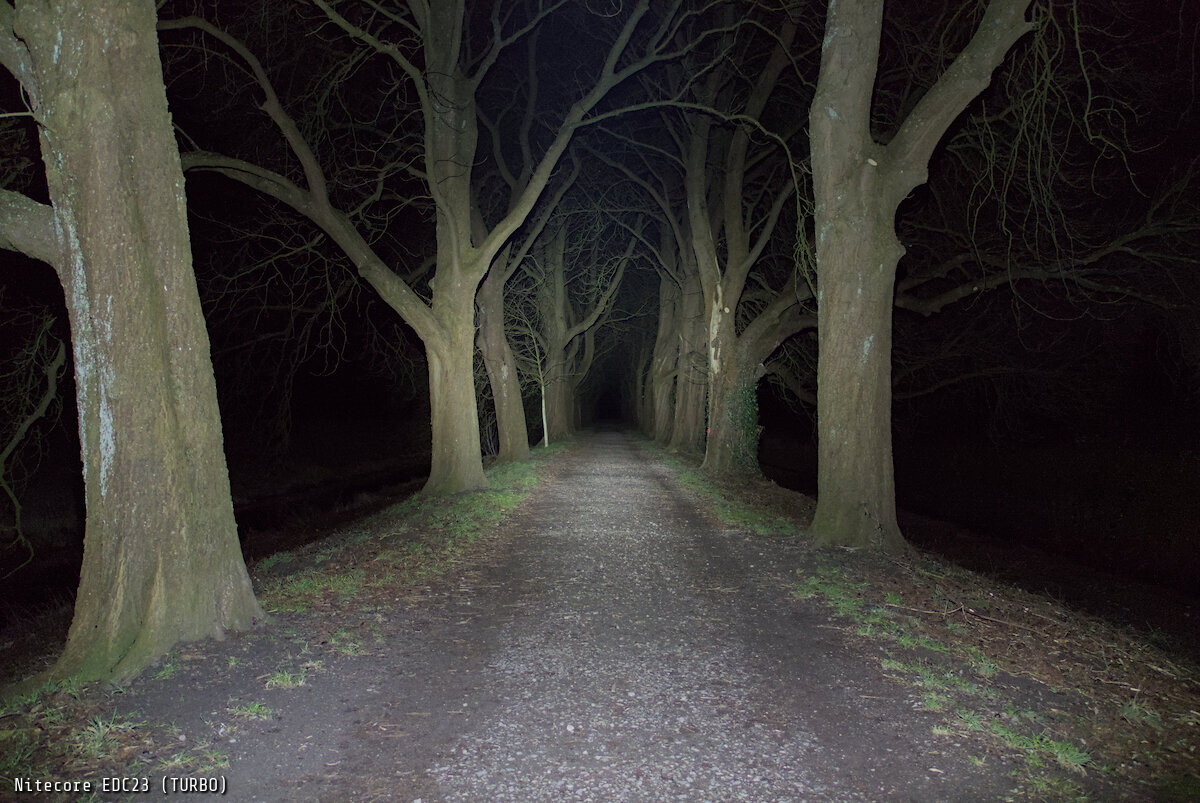
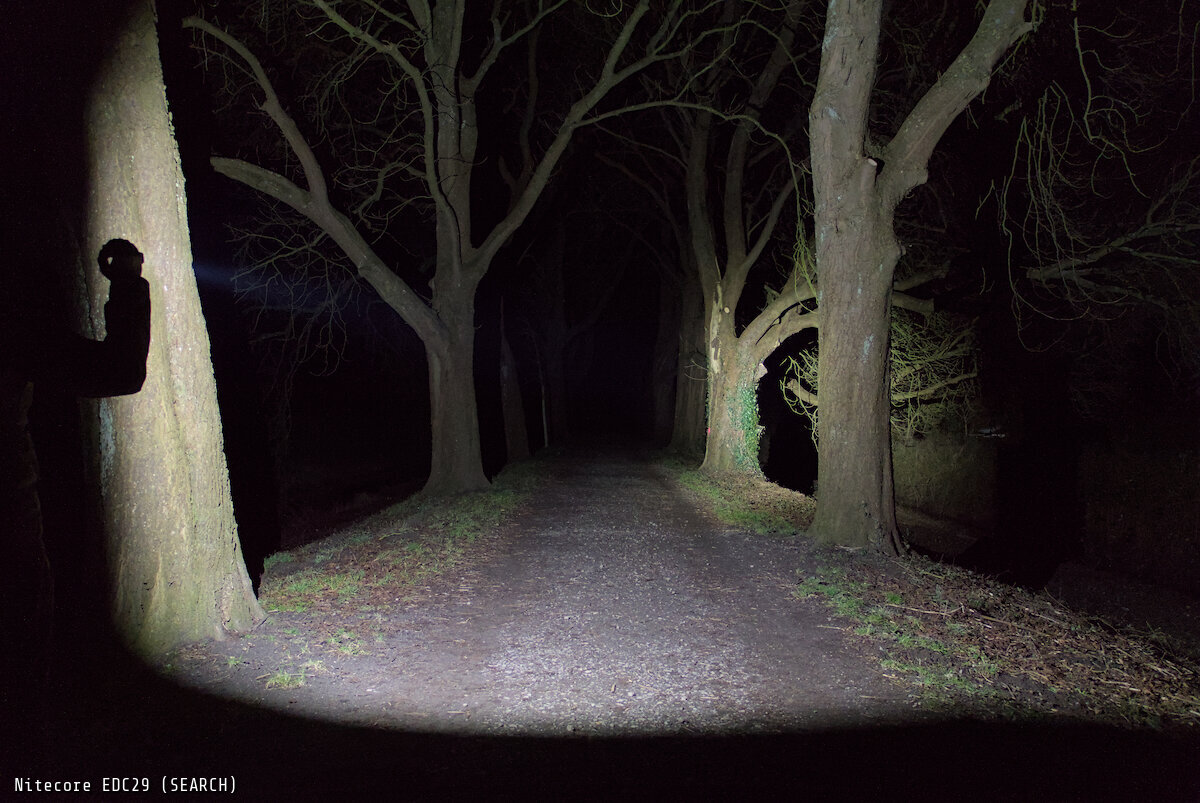
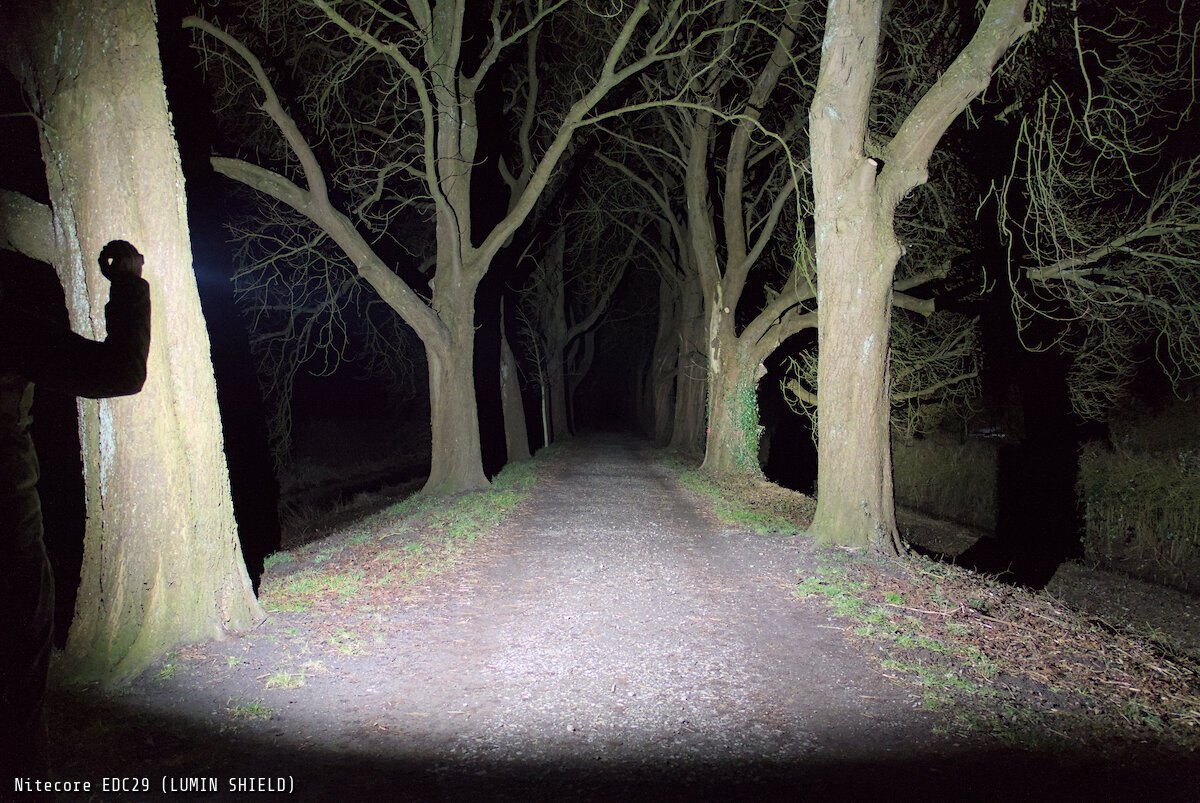
Driver and runtime
A constant current driver ensures efficient operation of the flashlight with constant brightness in low to medium levels. The range with Lumin Shield is somewhat shorter than with Search, as all the LEDs have to share the current.
| Mode | Brightness¹ | Runtime¹ | Intensity¹ (Throw²) |
|---|---|---|---|
| Lumin Shield | 6500 lm | ––– | 35 360 cd (370 m) |
| Search | 3000 lm | ––– | 40 230 cd (400 m) |
| High | 1200 lm | 2 h | 8 952 cd (190 m) |
| Mid | 400 lm | 3 h | 2 496 cd (100 m) |
| Low | 100 lm | 13 h | 1 158 cd (68 m) |
| Ultralow | 15 lm | 61 h | 230 cd (30 m) |
¹ According to manufacturer ² ANSI FL1
According to the manufacturer, the EDC29 achieves 6500 lm in Lumin Shield – at least for a few seconds. Even in Search and High, the flashlight heats up relatively quickly and has to reduce the brightness in order not to overheat. In the other modes however, the brightness is kept nice and constant.
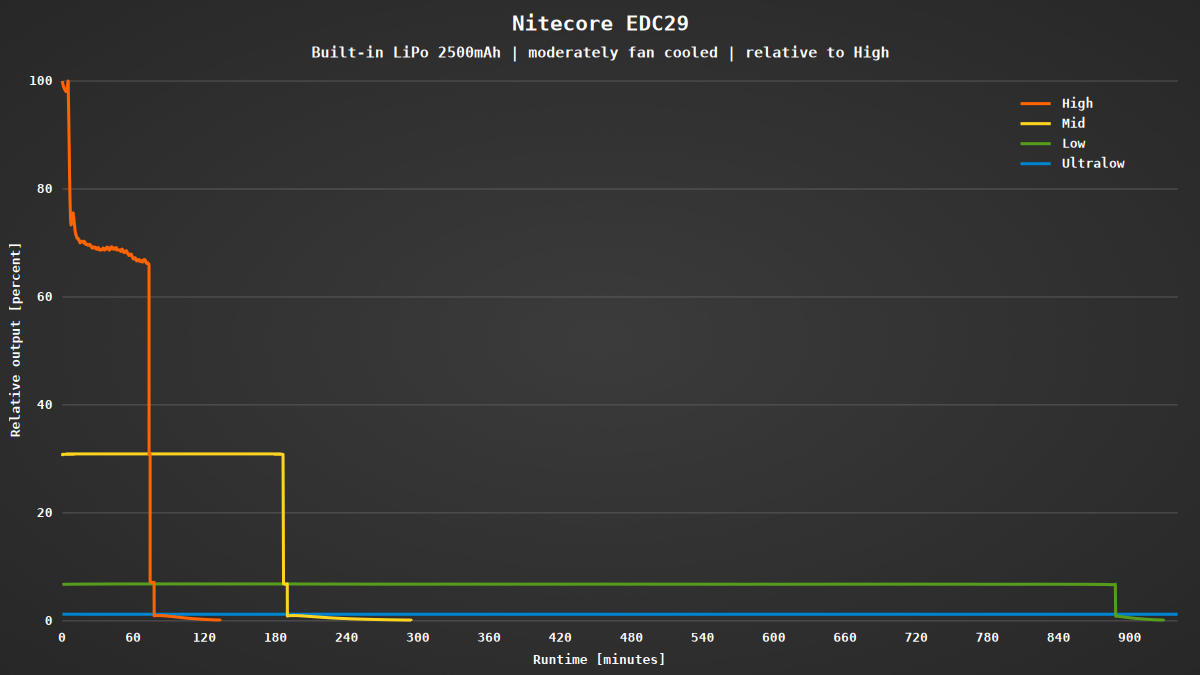
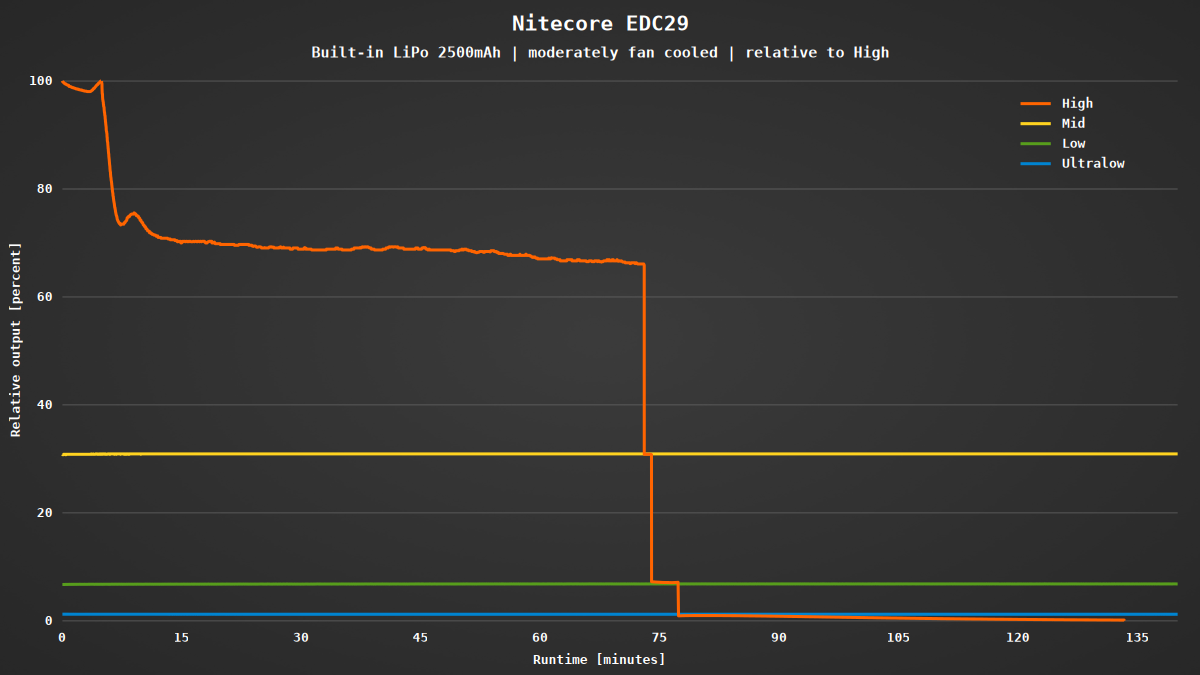
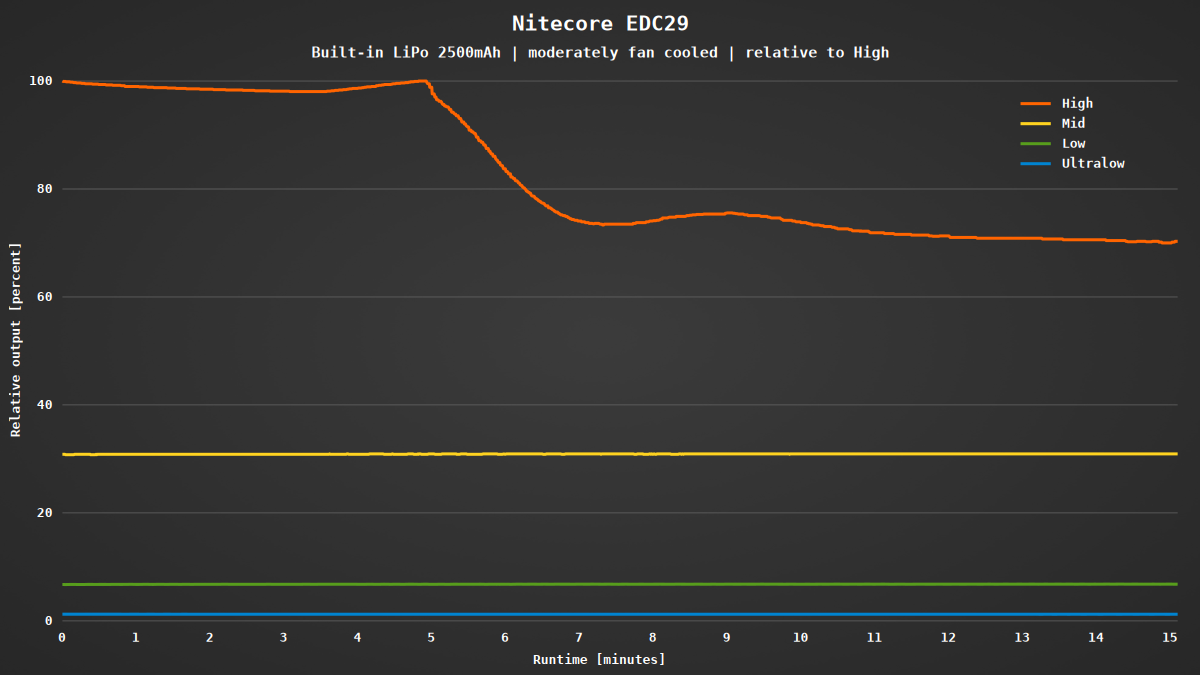
As the flashlight also has temperature regulation, cooling plays a certain role in the brightness and runtime. Without cooling – and thus lower brightness – the runtime in High matches the manufacturer’s specifications.
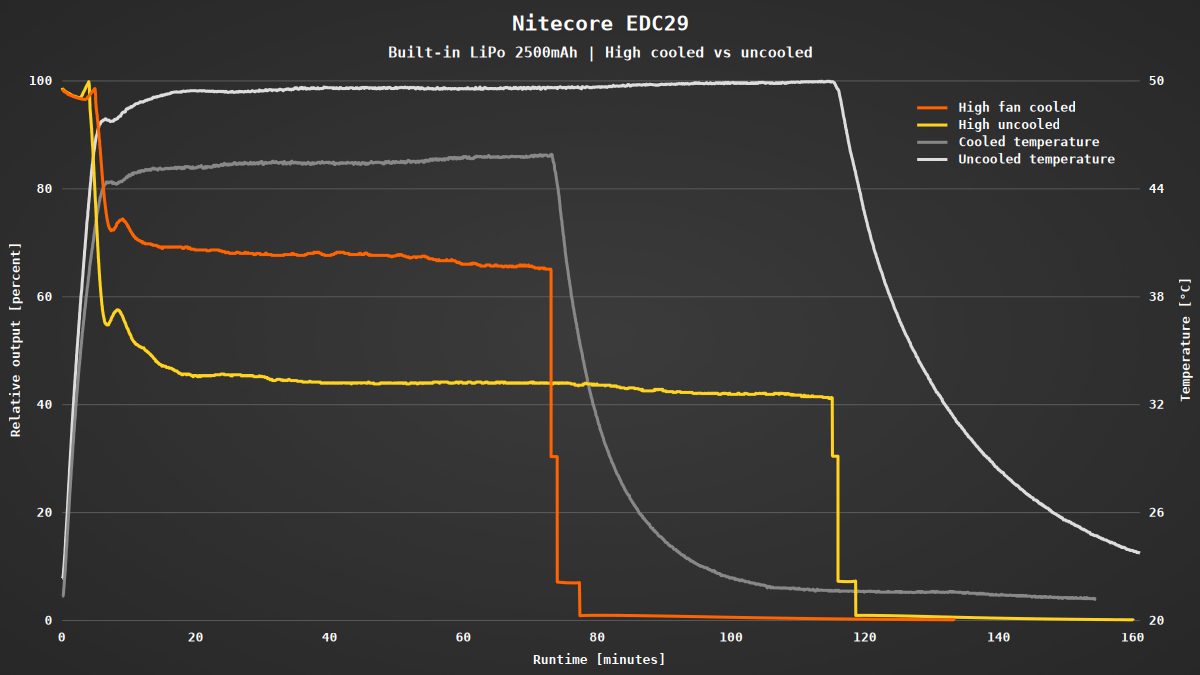
I have excluded Search and Lumin Shield from my regular runtime tests, as they are only active when the button is held down and are only available for a short time. A maximum of eight seconds at a time is possible, but this time might be reduced to less than a second if the flashlight is already hot.
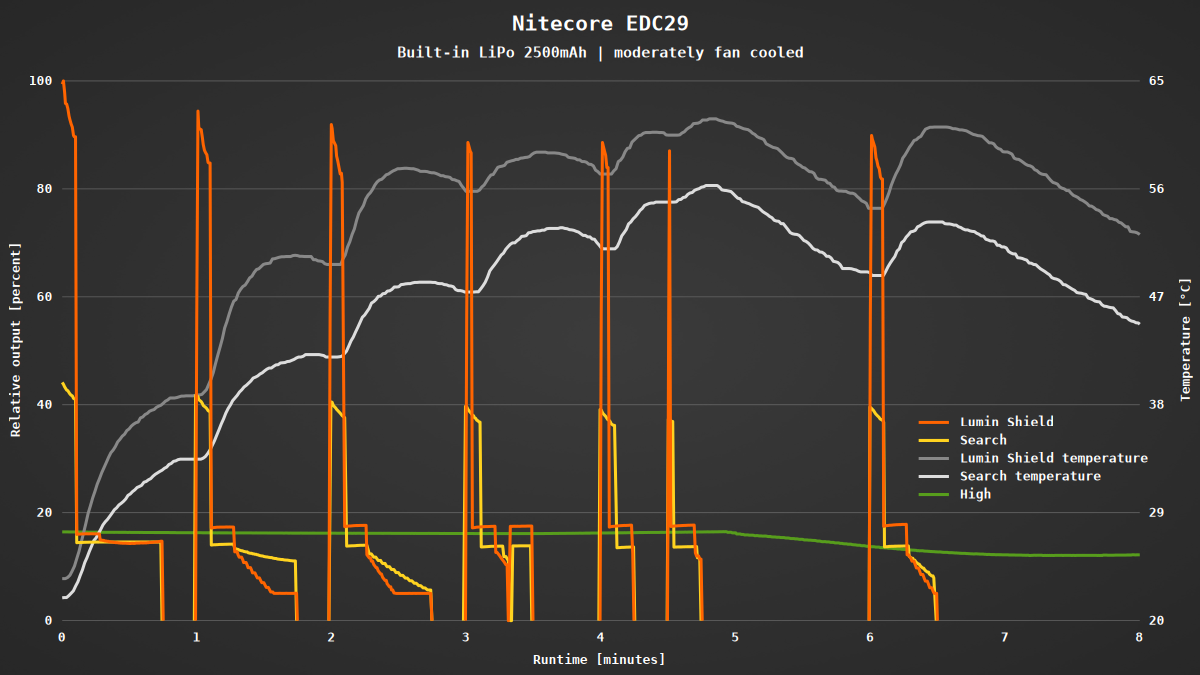
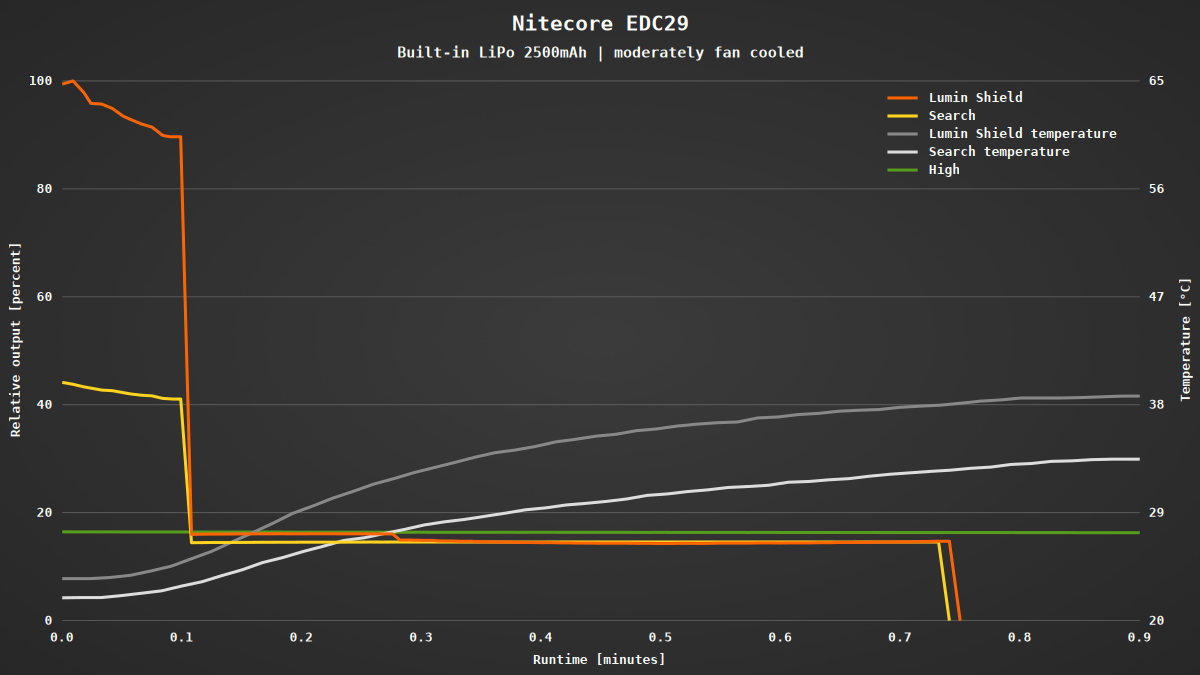
I was unable to measure the power consumption due to the inaccessible, built-in battery. However, the battery voltage is shown on the display, so I was able to determine that the flashlight switches off when the voltage drops below around 2.9 V to prevent the battery from discharging too deeply.

All levels are regulated by the constant current driver without PWM. Only Low and Mid show a small, almost sinusoidal modulation at 9.6 kHz with the scope, invisible to the human eye.
Conclusion
The Nitecore EDC23 flashlight has been my everyday companion for a few months. The Nitecore EDC29 is the perfect alternative when more light is needed. The two UHi 20 MAX LEDs are not only quite bright at 6500 lm, but also produce a wall of light in Lumin Shield mode. I also like the great UI with two buttons and the “Rapid Lock” lockout using a slide switch.
Given the compact design, it is not surprising that the flashlight heats up quickly and cannot maintain the high brightness for long. In the lower levels however, the constant current driver keeps the brightness pretty constant. Unfortunately it is not possible to choose freely between the wide and narrow beam for each brightness level. The permanently installed rechargeable battery can also be seen as a disadvantage.
Got curious? Here you can find the Nitecore EDC29 in the official Nitecore US store.
